Workplace Conflict Management
VerifiedAdded on 2020/02/05
|28
|11059
|52
Literature Review
AI Summary
This assignment delves into the complexities of workplace conflict, examining various factors that contribute to its occurrence. It analyzes different conflict management styles and provides insights into effective resolution strategies. The document emphasizes the importance of understanding conflict dynamics and implementing appropriate interventions to foster a harmonious and productive work environment.
Contribute Materials
Your contribution can guide someone’s learning journey. Share your
documents today.
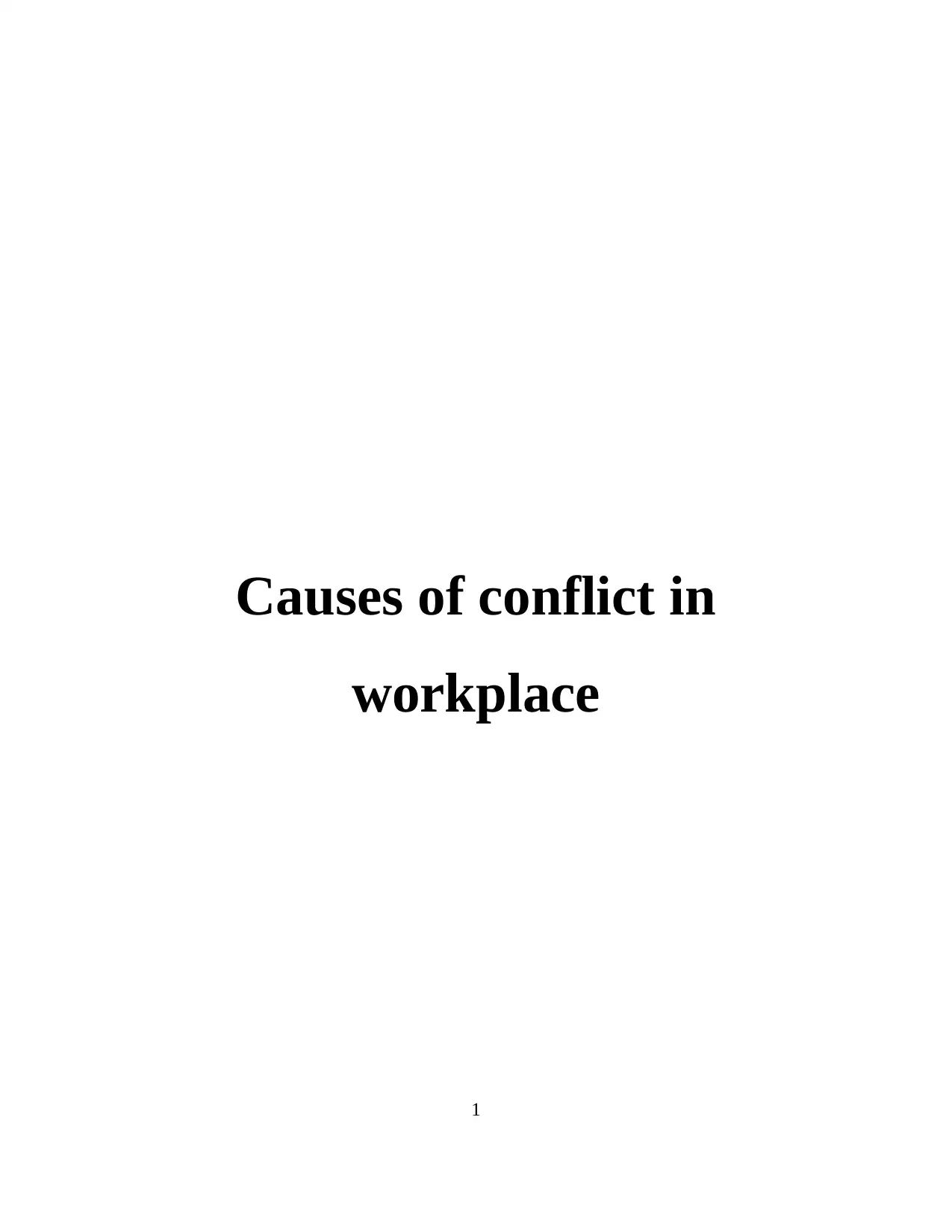
Causes of conflict in
workplace
1
workplace
1
Secure Best Marks with AI Grader
Need help grading? Try our AI Grader for instant feedback on your assignments.
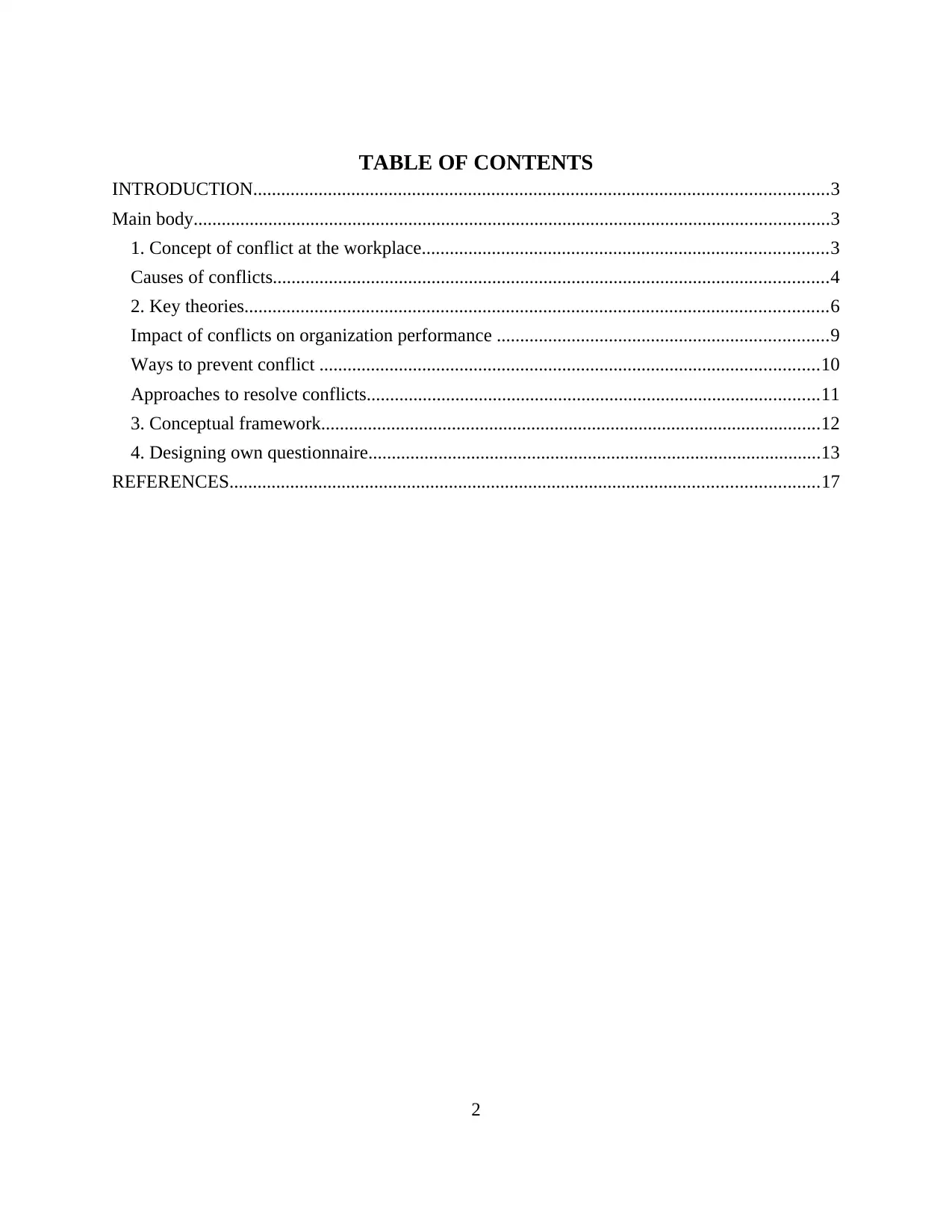
TABLE OF CONTENTS
INTRODUCTION...........................................................................................................................3
Main body........................................................................................................................................3
1. Concept of conflict at the workplace.......................................................................................3
Causes of conflicts.......................................................................................................................4
2. Key theories.............................................................................................................................6
Impact of conflicts on organization performance .......................................................................9
Ways to prevent conflict ...........................................................................................................10
Approaches to resolve conflicts.................................................................................................11
3. Conceptual framework...........................................................................................................12
4. Designing own questionnaire.................................................................................................13
REFERENCES..............................................................................................................................17
2
INTRODUCTION...........................................................................................................................3
Main body........................................................................................................................................3
1. Concept of conflict at the workplace.......................................................................................3
Causes of conflicts.......................................................................................................................4
2. Key theories.............................................................................................................................6
Impact of conflicts on organization performance .......................................................................9
Ways to prevent conflict ...........................................................................................................10
Approaches to resolve conflicts.................................................................................................11
3. Conceptual framework...........................................................................................................12
4. Designing own questionnaire.................................................................................................13
REFERENCES..............................................................................................................................17
2

2.0 INTRODUCTION
Literature review is the most important part of any study because it consists of different
tools and techniques which proves to be effective to collect large amount of information. It
assists researcher to get detail information related to particular topic and accordingly write the
detail description of the same. Generally, literature review is done by taking into account
different sources such as journals, books and online article. Furthermore, other available
information are also considered for writing literature review. The research issues of current study
is to assess causes of workplace conflict. In this regard, different themes will be prepared on the
basis of topic so as to develop better understanding among scholar. Apart from this, theories and
models are incorporated through which ways to integrate personnel can be implemented in the
business organization. It enables corporation to cater need of management as well as other
related parties.
MAIN BODY
2.1. Concept of conflict at the workplace
The conflict at workplace take place because of difference exist among employees in
term of personalities and values. It directly affects business organization because of poor
coordination among them (Abbas and Karage, 2015). This aspect tends to affect performance of
business as company need to focus upon good quality of services. It can be made possible only
with the help of integrated personnel. However, conflict exist between employees and employers
also which is followed by number of reasons (Baillien and De, 2009). Here, sharp disagreement
for opposing interest and ideas become the major reason behind conflict among personnel at
workplace. However, every organization face issue of conflict as people work together to
achieve common goals (Eddy, 2005). It can be beneficial or loss full for business where
management take corrective action to resolve the potential issue.
There are different types of conflicts such as personality differences, non-compliance
with rules and policies as well as misunderstanding. At last, competition remain the most
important form of conflict which many times proves to be good for business (Graham and
Folkes, 2014). However, many a times, conflict creates considerable ambivalence through which
scholar face issue in getting its exact meaning, relevant and ways to manage the same. In
3
Literature review is the most important part of any study because it consists of different
tools and techniques which proves to be effective to collect large amount of information. It
assists researcher to get detail information related to particular topic and accordingly write the
detail description of the same. Generally, literature review is done by taking into account
different sources such as journals, books and online article. Furthermore, other available
information are also considered for writing literature review. The research issues of current study
is to assess causes of workplace conflict. In this regard, different themes will be prepared on the
basis of topic so as to develop better understanding among scholar. Apart from this, theories and
models are incorporated through which ways to integrate personnel can be implemented in the
business organization. It enables corporation to cater need of management as well as other
related parties.
MAIN BODY
2.1. Concept of conflict at the workplace
The conflict at workplace take place because of difference exist among employees in
term of personalities and values. It directly affects business organization because of poor
coordination among them (Abbas and Karage, 2015). This aspect tends to affect performance of
business as company need to focus upon good quality of services. It can be made possible only
with the help of integrated personnel. However, conflict exist between employees and employers
also which is followed by number of reasons (Baillien and De, 2009). Here, sharp disagreement
for opposing interest and ideas become the major reason behind conflict among personnel at
workplace. However, every organization face issue of conflict as people work together to
achieve common goals (Eddy, 2005). It can be beneficial or loss full for business where
management take corrective action to resolve the potential issue.
There are different types of conflicts such as personality differences, non-compliance
with rules and policies as well as misunderstanding. At last, competition remain the most
important form of conflict which many times proves to be good for business (Graham and
Folkes, 2014). However, many a times, conflict creates considerable ambivalence through which
scholar face issue in getting its exact meaning, relevant and ways to manage the same. In
3

common parlance, conflict refers to the process whereby one party reflects that its interest is
being opposed by another one. It consists of different aspects such as angry words, actions of
opposition etc which in turn increase the conflict at workplace (Cullen and Hammer, 2007).
Generally, some people try to avoid situation of conflict because of their negative perception
towards the same. However, others perceive it as phenomenon necessary to manage whereas
some of the people consider that conflict provide good opportunity for personal growth
(DOBRE, 2012). It proves to be effective to cater need of buyers and meet their expectations in
an effectual manner.
At workplace, conflicts remain associated with heated debates, high frustration and raised
voices. Owing to this, businesses face issue in term of poor sales turnover, low profitability and
high attrition (Gifford, Gould, Latreille and Urwin, 2016). These kind of issues are resolved by
using appropriate strategy to integrate personnel with giving focus upon their issues. In this
regard, personnel can be invited to provide their suggestions for implementing appropriate
strategy (Jenkins, 2011). Here, they can communicate about problems which they are facing and
proposed solution can be derive from them. Such aspect ensure that management of corporation
respect for employees and ensure their inclusion in the decision making process. However, it
depends on management that how they resolve the issues or conflicts by focusing upon
constructive or poor process (Hershcovis, 2011). Thus, in business world, differences related to
peer group, environment, situation and personality as well as work experience tends to bring
variation in context of value or needs, personal attitudes and belief. All of these factors tend to
affect entire business performance because all individual behave in different manner (Lewis and
Gunn, 2007).
2.2 Critical review analysis of theory
Causes of conflicts
According to Nuzulia and Utami, (2014). It is very common for business to have different
types of conflicts at workplace. It affects personnel to cope up with changing scenario because
conflict generate negative feeling among them and they cannot pay attention on their work. Most
of the times, conflict is the reason behind high attrition rate through which personnel face issue
in delivering their good quality of services (Machyo, 2009). For example, service sector like
hotels face such kind of issues very frequently. Owing to this, personnel cannot achieve their
4
being opposed by another one. It consists of different aspects such as angry words, actions of
opposition etc which in turn increase the conflict at workplace (Cullen and Hammer, 2007).
Generally, some people try to avoid situation of conflict because of their negative perception
towards the same. However, others perceive it as phenomenon necessary to manage whereas
some of the people consider that conflict provide good opportunity for personal growth
(DOBRE, 2012). It proves to be effective to cater need of buyers and meet their expectations in
an effectual manner.
At workplace, conflicts remain associated with heated debates, high frustration and raised
voices. Owing to this, businesses face issue in term of poor sales turnover, low profitability and
high attrition (Gifford, Gould, Latreille and Urwin, 2016). These kind of issues are resolved by
using appropriate strategy to integrate personnel with giving focus upon their issues. In this
regard, personnel can be invited to provide their suggestions for implementing appropriate
strategy (Jenkins, 2011). Here, they can communicate about problems which they are facing and
proposed solution can be derive from them. Such aspect ensure that management of corporation
respect for employees and ensure their inclusion in the decision making process. However, it
depends on management that how they resolve the issues or conflicts by focusing upon
constructive or poor process (Hershcovis, 2011). Thus, in business world, differences related to
peer group, environment, situation and personality as well as work experience tends to bring
variation in context of value or needs, personal attitudes and belief. All of these factors tend to
affect entire business performance because all individual behave in different manner (Lewis and
Gunn, 2007).
2.2 Critical review analysis of theory
Causes of conflicts
According to Nuzulia and Utami, (2014). It is very common for business to have different
types of conflicts at workplace. It affects personnel to cope up with changing scenario because
conflict generate negative feeling among them and they cannot pay attention on their work. Most
of the times, conflict is the reason behind high attrition rate through which personnel face issue
in delivering their good quality of services (Machyo, 2009). For example, service sector like
hotels face such kind of issues very frequently. Owing to this, personnel cannot achieve their
4
Secure Best Marks with AI Grader
Need help grading? Try our AI Grader for instant feedback on your assignments.
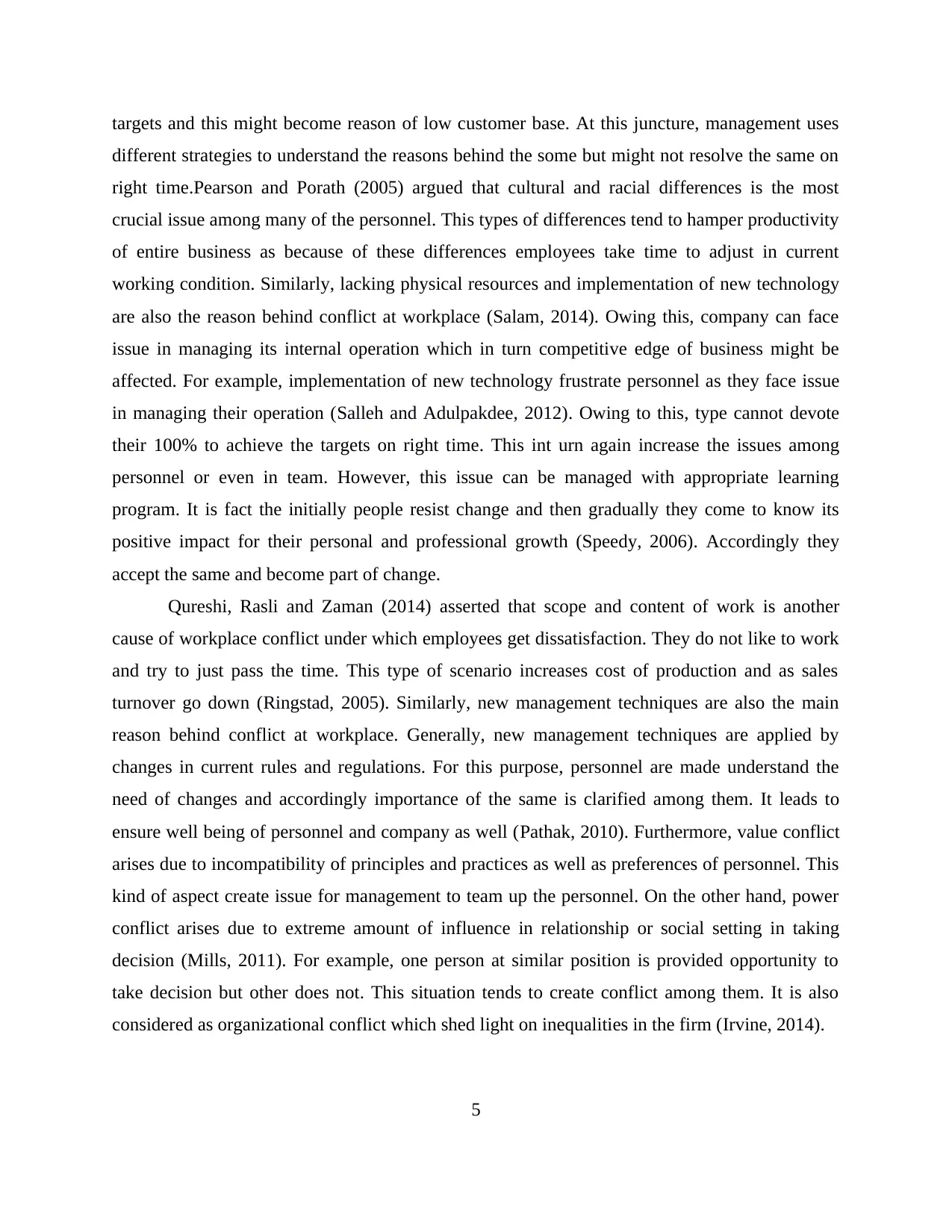
targets and this might become reason of low customer base. At this juncture, management uses
different strategies to understand the reasons behind the some but might not resolve the same on
right time.Pearson and Porath (2005) argued that cultural and racial differences is the most
crucial issue among many of the personnel. This types of differences tend to hamper productivity
of entire business as because of these differences employees take time to adjust in current
working condition. Similarly, lacking physical resources and implementation of new technology
are also the reason behind conflict at workplace (Salam, 2014). Owing this, company can face
issue in managing its internal operation which in turn competitive edge of business might be
affected. For example, implementation of new technology frustrate personnel as they face issue
in managing their operation (Salleh and Adulpakdee, 2012). Owing to this, type cannot devote
their 100% to achieve the targets on right time. This int urn again increase the issues among
personnel or even in team. However, this issue can be managed with appropriate learning
program. It is fact the initially people resist change and then gradually they come to know its
positive impact for their personal and professional growth (Speedy, 2006). Accordingly they
accept the same and become part of change.
Qureshi, Rasli and Zaman (2014) asserted that scope and content of work is another
cause of workplace conflict under which employees get dissatisfaction. They do not like to work
and try to just pass the time. This type of scenario increases cost of production and as sales
turnover go down (Ringstad, 2005). Similarly, new management techniques are also the main
reason behind conflict at workplace. Generally, new management techniques are applied by
changes in current rules and regulations. For this purpose, personnel are made understand the
need of changes and accordingly importance of the same is clarified among them. It leads to
ensure well being of personnel and company as well (Pathak, 2010). Furthermore, value conflict
arises due to incompatibility of principles and practices as well as preferences of personnel. This
kind of aspect create issue for management to team up the personnel. On the other hand, power
conflict arises due to extreme amount of influence in relationship or social setting in taking
decision (Mills, 2011). For example, one person at similar position is provided opportunity to
take decision but other does not. This situation tends to create conflict among them. It is also
considered as organizational conflict which shed light on inequalities in the firm (Irvine, 2014).
5
different strategies to understand the reasons behind the some but might not resolve the same on
right time.Pearson and Porath (2005) argued that cultural and racial differences is the most
crucial issue among many of the personnel. This types of differences tend to hamper productivity
of entire business as because of these differences employees take time to adjust in current
working condition. Similarly, lacking physical resources and implementation of new technology
are also the reason behind conflict at workplace (Salam, 2014). Owing this, company can face
issue in managing its internal operation which in turn competitive edge of business might be
affected. For example, implementation of new technology frustrate personnel as they face issue
in managing their operation (Salleh and Adulpakdee, 2012). Owing to this, type cannot devote
their 100% to achieve the targets on right time. This int urn again increase the issues among
personnel or even in team. However, this issue can be managed with appropriate learning
program. It is fact the initially people resist change and then gradually they come to know its
positive impact for their personal and professional growth (Speedy, 2006). Accordingly they
accept the same and become part of change.
Qureshi, Rasli and Zaman (2014) asserted that scope and content of work is another
cause of workplace conflict under which employees get dissatisfaction. They do not like to work
and try to just pass the time. This type of scenario increases cost of production and as sales
turnover go down (Ringstad, 2005). Similarly, new management techniques are also the main
reason behind conflict at workplace. Generally, new management techniques are applied by
changes in current rules and regulations. For this purpose, personnel are made understand the
need of changes and accordingly importance of the same is clarified among them. It leads to
ensure well being of personnel and company as well (Pathak, 2010). Furthermore, value conflict
arises due to incompatibility of principles and practices as well as preferences of personnel. This
kind of aspect create issue for management to team up the personnel. On the other hand, power
conflict arises due to extreme amount of influence in relationship or social setting in taking
decision (Mills, 2011). For example, one person at similar position is provided opportunity to
take decision but other does not. This situation tends to create conflict among them. It is also
considered as organizational conflict which shed light on inequalities in the firm (Irvine, 2014).
5
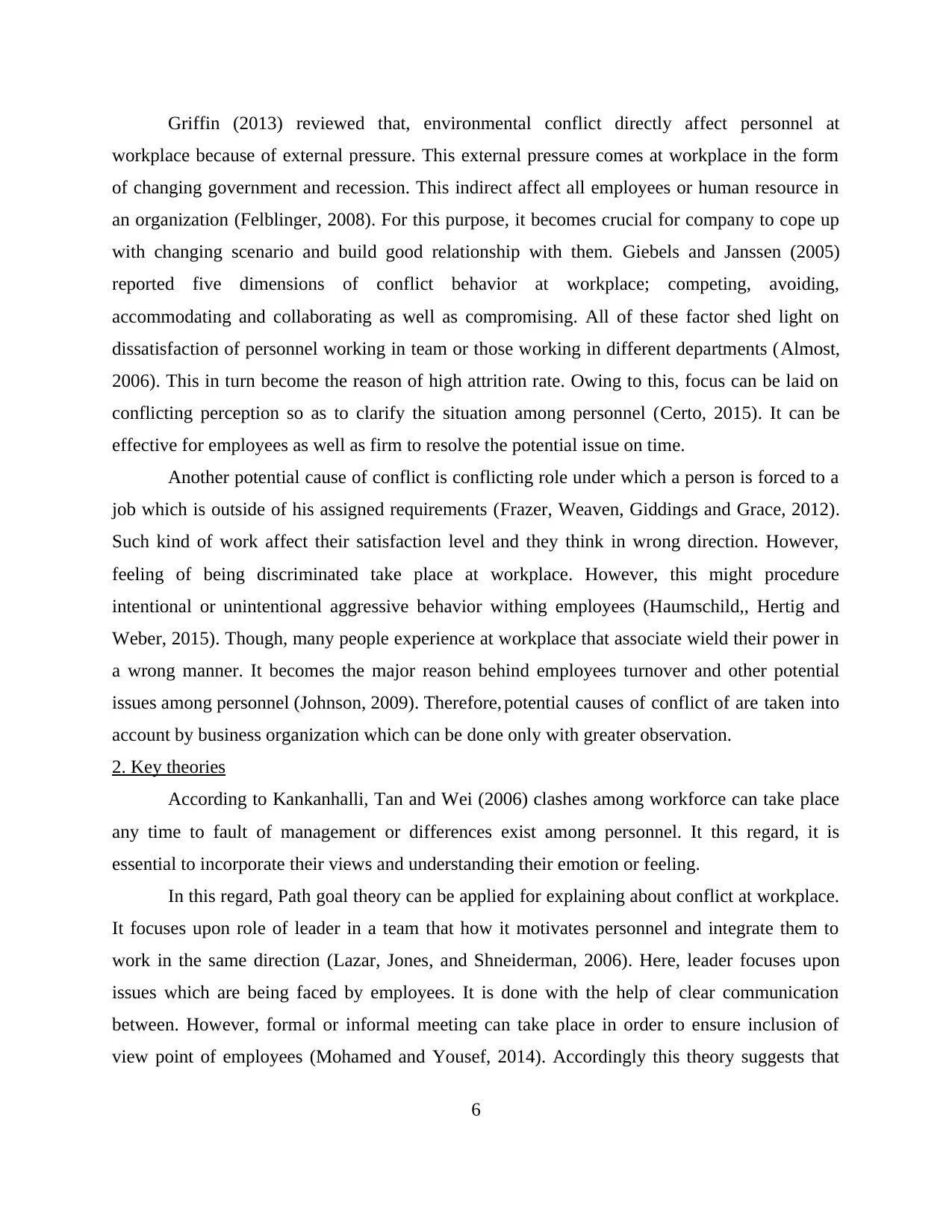
Griffin (2013) reviewed that, environmental conflict directly affect personnel at
workplace because of external pressure. This external pressure comes at workplace in the form
of changing government and recession. This indirect affect all employees or human resource in
an organization (Felblinger, 2008). For this purpose, it becomes crucial for company to cope up
with changing scenario and build good relationship with them. Giebels and Janssen (2005)
reported five dimensions of conflict behavior at workplace; competing, avoiding,
accommodating and collaborating as well as compromising. All of these factor shed light on
dissatisfaction of personnel working in team or those working in different departments (Almost,
2006). This in turn become the reason of high attrition rate. Owing to this, focus can be laid on
conflicting perception so as to clarify the situation among personnel (Certo, 2015). It can be
effective for employees as well as firm to resolve the potential issue on time.
Another potential cause of conflict is conflicting role under which a person is forced to a
job which is outside of his assigned requirements (Frazer, Weaven, Giddings and Grace, 2012).
Such kind of work affect their satisfaction level and they think in wrong direction. However,
feeling of being discriminated take place at workplace. However, this might procedure
intentional or unintentional aggressive behavior withing employees (Haumschild,, Hertig and
Weber, 2015). Though, many people experience at workplace that associate wield their power in
a wrong manner. It becomes the major reason behind employees turnover and other potential
issues among personnel (Johnson, 2009). Therefore, potential causes of conflict of are taken into
account by business organization which can be done only with greater observation.
2. Key theories
According to Kankanhalli, Tan and Wei (2006) clashes among workforce can take place
any time to fault of management or differences exist among personnel. It this regard, it is
essential to incorporate their views and understanding their emotion or feeling.
In this regard, Path goal theory can be applied for explaining about conflict at workplace.
It focuses upon role of leader in a team that how it motivates personnel and integrate them to
work in the same direction (Lazar, Jones, and Shneiderman, 2006). Here, leader focuses upon
issues which are being faced by employees. It is done with the help of clear communication
between. However, formal or informal meeting can take place in order to ensure inclusion of
view point of employees (Mohamed and Yousef, 2014). Accordingly this theory suggests that
6
workplace because of external pressure. This external pressure comes at workplace in the form
of changing government and recession. This indirect affect all employees or human resource in
an organization (Felblinger, 2008). For this purpose, it becomes crucial for company to cope up
with changing scenario and build good relationship with them. Giebels and Janssen (2005)
reported five dimensions of conflict behavior at workplace; competing, avoiding,
accommodating and collaborating as well as compromising. All of these factor shed light on
dissatisfaction of personnel working in team or those working in different departments (Almost,
2006). This in turn become the reason of high attrition rate. Owing to this, focus can be laid on
conflicting perception so as to clarify the situation among personnel (Certo, 2015). It can be
effective for employees as well as firm to resolve the potential issue on time.
Another potential cause of conflict is conflicting role under which a person is forced to a
job which is outside of his assigned requirements (Frazer, Weaven, Giddings and Grace, 2012).
Such kind of work affect their satisfaction level and they think in wrong direction. However,
feeling of being discriminated take place at workplace. However, this might procedure
intentional or unintentional aggressive behavior withing employees (Haumschild,, Hertig and
Weber, 2015). Though, many people experience at workplace that associate wield their power in
a wrong manner. It becomes the major reason behind employees turnover and other potential
issues among personnel (Johnson, 2009). Therefore, potential causes of conflict of are taken into
account by business organization which can be done only with greater observation.
2. Key theories
According to Kankanhalli, Tan and Wei (2006) clashes among workforce can take place
any time to fault of management or differences exist among personnel. It this regard, it is
essential to incorporate their views and understanding their emotion or feeling.
In this regard, Path goal theory can be applied for explaining about conflict at workplace.
It focuses upon role of leader in a team that how it motivates personnel and integrate them to
work in the same direction (Lazar, Jones, and Shneiderman, 2006). Here, leader focuses upon
issues which are being faced by employees. It is done with the help of clear communication
between. However, formal or informal meeting can take place in order to ensure inclusion of
view point of employees (Mohamed and Yousef, 2014). Accordingly this theory suggests that
6
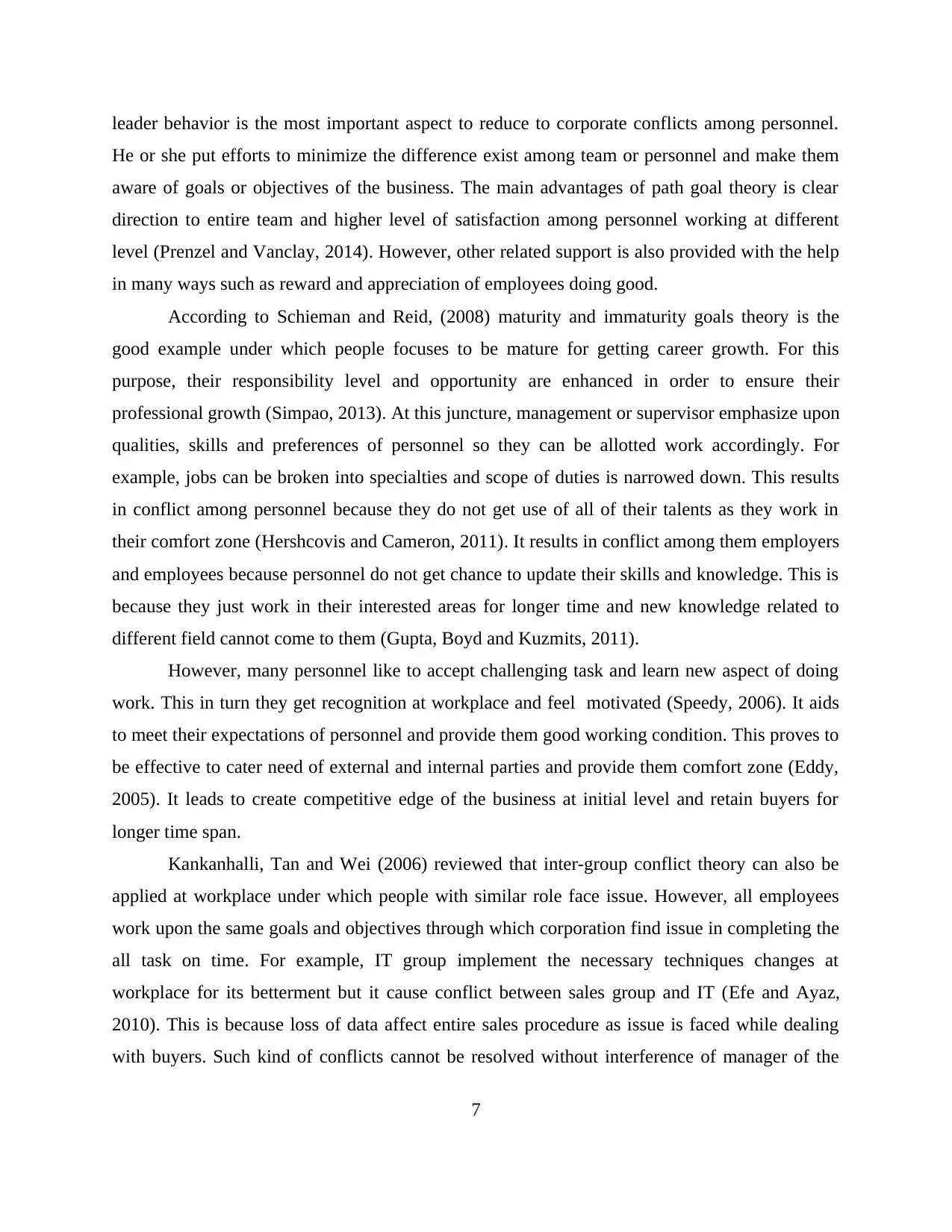
leader behavior is the most important aspect to reduce to corporate conflicts among personnel.
He or she put efforts to minimize the difference exist among team or personnel and make them
aware of goals or objectives of the business. The main advantages of path goal theory is clear
direction to entire team and higher level of satisfaction among personnel working at different
level (Prenzel and Vanclay, 2014). However, other related support is also provided with the help
in many ways such as reward and appreciation of employees doing good.
According to Schieman and Reid, (2008) maturity and immaturity goals theory is the
good example under which people focuses to be mature for getting career growth. For this
purpose, their responsibility level and opportunity are enhanced in order to ensure their
professional growth (Simpao, 2013). At this juncture, management or supervisor emphasize upon
qualities, skills and preferences of personnel so they can be allotted work accordingly. For
example, jobs can be broken into specialties and scope of duties is narrowed down. This results
in conflict among personnel because they do not get use of all of their talents as they work in
their comfort zone (Hershcovis and Cameron, 2011). It results in conflict among them employers
and employees because personnel do not get chance to update their skills and knowledge. This is
because they just work in their interested areas for longer time and new knowledge related to
different field cannot come to them (Gupta, Boyd and Kuzmits, 2011).
However, many personnel like to accept challenging task and learn new aspect of doing
work. This in turn they get recognition at workplace and feel motivated (Speedy, 2006). It aids
to meet their expectations of personnel and provide them good working condition. This proves to
be effective to cater need of external and internal parties and provide them comfort zone (Eddy,
2005). It leads to create competitive edge of the business at initial level and retain buyers for
longer time span.
Kankanhalli, Tan and Wei (2006) reviewed that inter-group conflict theory can also be
applied at workplace under which people with similar role face issue. However, all employees
work upon the same goals and objectives through which corporation find issue in completing the
all task on time. For example, IT group implement the necessary techniques changes at
workplace for its betterment but it cause conflict between sales group and IT (Efe and Ayaz,
2010). This is because loss of data affect entire sales procedure as issue is faced while dealing
with buyers. Such kind of conflicts cannot be resolved without interference of manager of the
7
He or she put efforts to minimize the difference exist among team or personnel and make them
aware of goals or objectives of the business. The main advantages of path goal theory is clear
direction to entire team and higher level of satisfaction among personnel working at different
level (Prenzel and Vanclay, 2014). However, other related support is also provided with the help
in many ways such as reward and appreciation of employees doing good.
According to Schieman and Reid, (2008) maturity and immaturity goals theory is the
good example under which people focuses to be mature for getting career growth. For this
purpose, their responsibility level and opportunity are enhanced in order to ensure their
professional growth (Simpao, 2013). At this juncture, management or supervisor emphasize upon
qualities, skills and preferences of personnel so they can be allotted work accordingly. For
example, jobs can be broken into specialties and scope of duties is narrowed down. This results
in conflict among personnel because they do not get use of all of their talents as they work in
their comfort zone (Hershcovis and Cameron, 2011). It results in conflict among them employers
and employees because personnel do not get chance to update their skills and knowledge. This is
because they just work in their interested areas for longer time and new knowledge related to
different field cannot come to them (Gupta, Boyd and Kuzmits, 2011).
However, many personnel like to accept challenging task and learn new aspect of doing
work. This in turn they get recognition at workplace and feel motivated (Speedy, 2006). It aids
to meet their expectations of personnel and provide them good working condition. This proves to
be effective to cater need of external and internal parties and provide them comfort zone (Eddy,
2005). It leads to create competitive edge of the business at initial level and retain buyers for
longer time span.
Kankanhalli, Tan and Wei (2006) reviewed that inter-group conflict theory can also be
applied at workplace under which people with similar role face issue. However, all employees
work upon the same goals and objectives through which corporation find issue in completing the
all task on time. For example, IT group implement the necessary techniques changes at
workplace for its betterment but it cause conflict between sales group and IT (Efe and Ayaz,
2010). This is because loss of data affect entire sales procedure as issue is faced while dealing
with buyers. Such kind of conflicts cannot be resolved without interference of manager of the
7
Paraphrase This Document
Need a fresh take? Get an instant paraphrase of this document with our AI Paraphraser
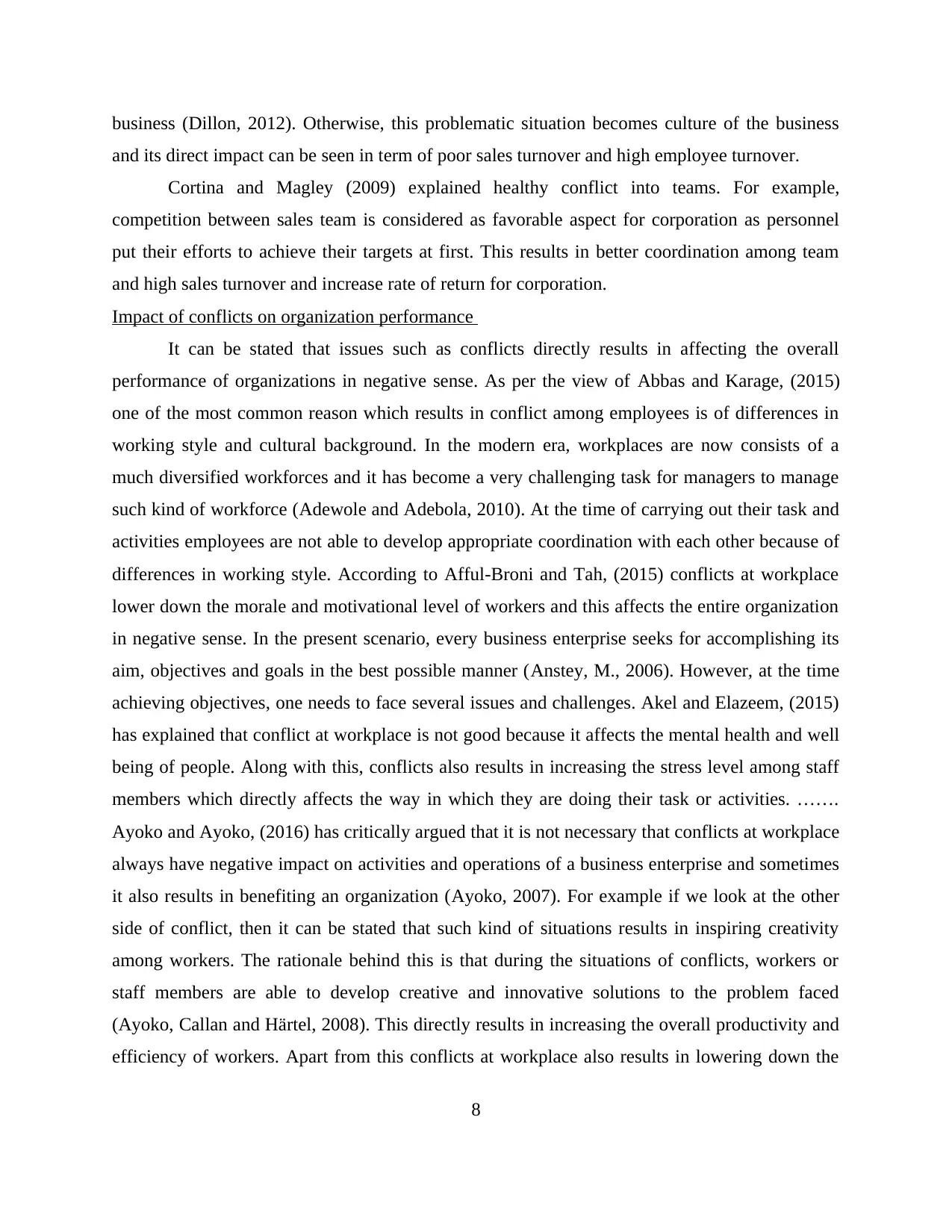
business (Dillon, 2012). Otherwise, this problematic situation becomes culture of the business
and its direct impact can be seen in term of poor sales turnover and high employee turnover.
Cortina and Magley (2009) explained healthy conflict into teams. For example,
competition between sales team is considered as favorable aspect for corporation as personnel
put their efforts to achieve their targets at first. This results in better coordination among team
and high sales turnover and increase rate of return for corporation.
Impact of conflicts on organization performance
It can be stated that issues such as conflicts directly results in affecting the overall
performance of organizations in negative sense. As per the view of Abbas and Karage, (2015)
one of the most common reason which results in conflict among employees is of differences in
working style and cultural background. In the modern era, workplaces are now consists of a
much diversified workforces and it has become a very challenging task for managers to manage
such kind of workforce (Adewole and Adebola, 2010). At the time of carrying out their task and
activities employees are not able to develop appropriate coordination with each other because of
differences in working style. According to Afful-Broni and Tah, (2015) conflicts at workplace
lower down the morale and motivational level of workers and this affects the entire organization
in negative sense. In the present scenario, every business enterprise seeks for accomplishing its
aim, objectives and goals in the best possible manner (Anstey, M., 2006). However, at the time
achieving objectives, one needs to face several issues and challenges. Akel and Elazeem, (2015)
has explained that conflict at workplace is not good because it affects the mental health and well
being of people. Along with this, conflicts also results in increasing the stress level among staff
members which directly affects the way in which they are doing their task or activities. …….
Ayoko and Ayoko, (2016) has critically argued that it is not necessary that conflicts at workplace
always have negative impact on activities and operations of a business enterprise and sometimes
it also results in benefiting an organization (Ayoko, 2007). For example if we look at the other
side of conflict, then it can be stated that such kind of situations results in inspiring creativity
among workers. The rationale behind this is that during the situations of conflicts, workers or
staff members are able to develop creative and innovative solutions to the problem faced
(Ayoko, Callan and Härtel, 2008). This directly results in increasing the overall productivity and
efficiency of workers. Apart from this conflicts at workplace also results in lowering down the
8
and its direct impact can be seen in term of poor sales turnover and high employee turnover.
Cortina and Magley (2009) explained healthy conflict into teams. For example,
competition between sales team is considered as favorable aspect for corporation as personnel
put their efforts to achieve their targets at first. This results in better coordination among team
and high sales turnover and increase rate of return for corporation.
Impact of conflicts on organization performance
It can be stated that issues such as conflicts directly results in affecting the overall
performance of organizations in negative sense. As per the view of Abbas and Karage, (2015)
one of the most common reason which results in conflict among employees is of differences in
working style and cultural background. In the modern era, workplaces are now consists of a
much diversified workforces and it has become a very challenging task for managers to manage
such kind of workforce (Adewole and Adebola, 2010). At the time of carrying out their task and
activities employees are not able to develop appropriate coordination with each other because of
differences in working style. According to Afful-Broni and Tah, (2015) conflicts at workplace
lower down the morale and motivational level of workers and this affects the entire organization
in negative sense. In the present scenario, every business enterprise seeks for accomplishing its
aim, objectives and goals in the best possible manner (Anstey, M., 2006). However, at the time
achieving objectives, one needs to face several issues and challenges. Akel and Elazeem, (2015)
has explained that conflict at workplace is not good because it affects the mental health and well
being of people. Along with this, conflicts also results in increasing the stress level among staff
members which directly affects the way in which they are doing their task or activities. …….
Ayoko and Ayoko, (2016) has critically argued that it is not necessary that conflicts at workplace
always have negative impact on activities and operations of a business enterprise and sometimes
it also results in benefiting an organization (Ayoko, 2007). For example if we look at the other
side of conflict, then it can be stated that such kind of situations results in inspiring creativity
among workers. The rationale behind this is that during the situations of conflicts, workers or
staff members are able to develop creative and innovative solutions to the problem faced
(Ayoko, Callan and Härtel, 2008). This directly results in increasing the overall productivity and
efficiency of workers. Apart from this conflicts at workplace also results in lowering down the
8
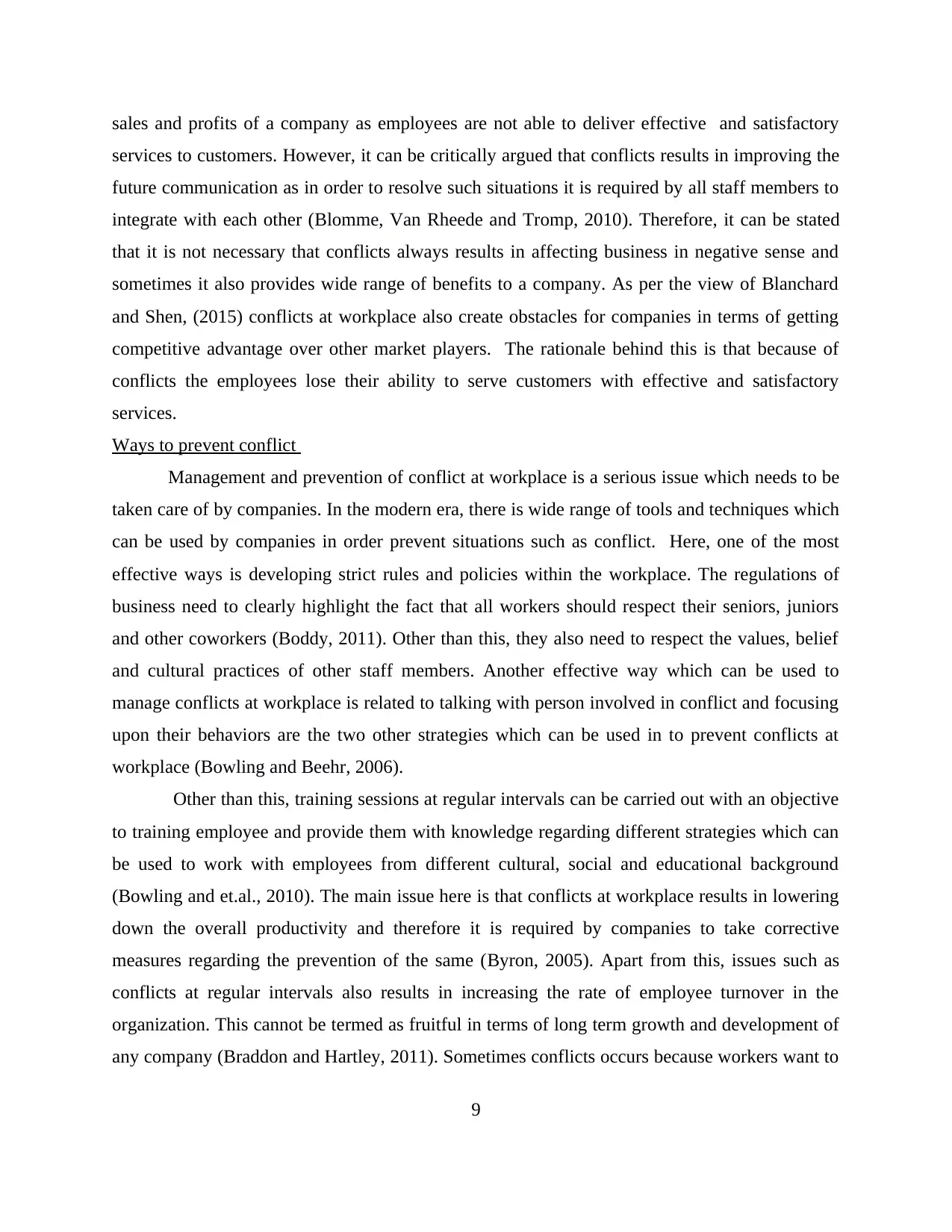
sales and profits of a company as employees are not able to deliver effective and satisfactory
services to customers. However, it can be critically argued that conflicts results in improving the
future communication as in order to resolve such situations it is required by all staff members to
integrate with each other (Blomme, Van Rheede and Tromp, 2010). Therefore, it can be stated
that it is not necessary that conflicts always results in affecting business in negative sense and
sometimes it also provides wide range of benefits to a company. As per the view of Blanchard
and Shen, (2015) conflicts at workplace also create obstacles for companies in terms of getting
competitive advantage over other market players. The rationale behind this is that because of
conflicts the employees lose their ability to serve customers with effective and satisfactory
services.
Ways to prevent conflict
Management and prevention of conflict at workplace is a serious issue which needs to be
taken care of by companies. In the modern era, there is wide range of tools and techniques which
can be used by companies in order prevent situations such as conflict. Here, one of the most
effective ways is developing strict rules and policies within the workplace. The regulations of
business need to clearly highlight the fact that all workers should respect their seniors, juniors
and other coworkers (Boddy, 2011). Other than this, they also need to respect the values, belief
and cultural practices of other staff members. Another effective way which can be used to
manage conflicts at workplace is related to talking with person involved in conflict and focusing
upon their behaviors are the two other strategies which can be used in to prevent conflicts at
workplace (Bowling and Beehr, 2006).
Other than this, training sessions at regular intervals can be carried out with an objective
to training employee and provide them with knowledge regarding different strategies which can
be used to work with employees from different cultural, social and educational background
(Bowling and et.al., 2010). The main issue here is that conflicts at workplace results in lowering
down the overall productivity and therefore it is required by companies to take corrective
measures regarding the prevention of the same (Byron, 2005). Apart from this, issues such as
conflicts at regular intervals also results in increasing the rate of employee turnover in the
organization. This cannot be termed as fruitful in terms of long term growth and development of
any company (Braddon and Hartley, 2011). Sometimes conflicts occurs because workers want to
9
services to customers. However, it can be critically argued that conflicts results in improving the
future communication as in order to resolve such situations it is required by all staff members to
integrate with each other (Blomme, Van Rheede and Tromp, 2010). Therefore, it can be stated
that it is not necessary that conflicts always results in affecting business in negative sense and
sometimes it also provides wide range of benefits to a company. As per the view of Blanchard
and Shen, (2015) conflicts at workplace also create obstacles for companies in terms of getting
competitive advantage over other market players. The rationale behind this is that because of
conflicts the employees lose their ability to serve customers with effective and satisfactory
services.
Ways to prevent conflict
Management and prevention of conflict at workplace is a serious issue which needs to be
taken care of by companies. In the modern era, there is wide range of tools and techniques which
can be used by companies in order prevent situations such as conflict. Here, one of the most
effective ways is developing strict rules and policies within the workplace. The regulations of
business need to clearly highlight the fact that all workers should respect their seniors, juniors
and other coworkers (Boddy, 2011). Other than this, they also need to respect the values, belief
and cultural practices of other staff members. Another effective way which can be used to
manage conflicts at workplace is related to talking with person involved in conflict and focusing
upon their behaviors are the two other strategies which can be used in to prevent conflicts at
workplace (Bowling and Beehr, 2006).
Other than this, training sessions at regular intervals can be carried out with an objective
to training employee and provide them with knowledge regarding different strategies which can
be used to work with employees from different cultural, social and educational background
(Bowling and et.al., 2010). The main issue here is that conflicts at workplace results in lowering
down the overall productivity and therefore it is required by companies to take corrective
measures regarding the prevention of the same (Byron, 2005). Apart from this, issues such as
conflicts at regular intervals also results in increasing the rate of employee turnover in the
organization. This cannot be termed as fruitful in terms of long term growth and development of
any company (Braddon and Hartley, 2011). Sometimes conflicts occurs because workers want to
9

say lots of things but they are not provides with adequate opportunities regarding the same. This
results in increasing the level of frustrations among staff members and also encourages them to
indulge in practices such as conflicts at work (Cahn and Abigail, 2007). In order to deal with
such kind of situation what businesses can really do is that they can implement participative style
of leadership within an organization (Briggs, Kolfschoten and Vreede, 2005). This will help in
encouraging the views and opinion of other workers and develop sense of satisfaction among
them. However Buzzanell and Liu, (2007) has argued that the main drawback of using
democratic or participative leadership style is that delay the process of decision making and
affect entire organization in negative sense.
Approaches to resolve conflicts
Conflict at workplace need to be resolved in relatively less time span for its better flow of
production and long run growth in the marketplace. There are several approaches used for
resolution of conflicts such as avoidance, soothing, confrontation and compromise. These
approaches emphasize upon time saving and assurance of better coordination among personnel.
According to Datta, Guthrie, Basuil and Pandey, (2010) clear communication between team is
the most effective aspect to resolve the situation of conflict. Here, company can focus upon
imparting training to personnel for appropriate team building aspect and its potential impact on
overall growth and development. However, communication can be ensured by using appropriate
mode of communication such as e-mail, newsletter and face to face communication. At this
juncture, formal and information meetings are taken on weekly or daily basis (Burke, 2010). This
prove to be effective for personnel to share their issues and get them resolved on right time.
Haumschild, Hertig, and Weber (2015) reported that confrontation method focuses upon
solution of the conflict any how. Here, manager or third party is involved conflicting parties so
as to sort that out on right time. It might take same time because of disagreement and different
opinion of parties but facilitates to reach at fruitful outcome. On the other hand, compromising is
another approach for resolving conflicts wherein both parties agree upon the common ground
(Danielsson, Bodin, Wulff and Theorell, 2015). It aids to save time and ensure appropriate
integration of personnel. This in turn business can increase overall rate of return and retain
workforce for longer time span. Apart from this, Hutchinson, Vickers, Jackson and Wilkes,
(2006) asserted that collaborative approach is important for business through which mutually
10
results in increasing the level of frustrations among staff members and also encourages them to
indulge in practices such as conflicts at work (Cahn and Abigail, 2007). In order to deal with
such kind of situation what businesses can really do is that they can implement participative style
of leadership within an organization (Briggs, Kolfschoten and Vreede, 2005). This will help in
encouraging the views and opinion of other workers and develop sense of satisfaction among
them. However Buzzanell and Liu, (2007) has argued that the main drawback of using
democratic or participative leadership style is that delay the process of decision making and
affect entire organization in negative sense.
Approaches to resolve conflicts
Conflict at workplace need to be resolved in relatively less time span for its better flow of
production and long run growth in the marketplace. There are several approaches used for
resolution of conflicts such as avoidance, soothing, confrontation and compromise. These
approaches emphasize upon time saving and assurance of better coordination among personnel.
According to Datta, Guthrie, Basuil and Pandey, (2010) clear communication between team is
the most effective aspect to resolve the situation of conflict. Here, company can focus upon
imparting training to personnel for appropriate team building aspect and its potential impact on
overall growth and development. However, communication can be ensured by using appropriate
mode of communication such as e-mail, newsletter and face to face communication. At this
juncture, formal and information meetings are taken on weekly or daily basis (Burke, 2010). This
prove to be effective for personnel to share their issues and get them resolved on right time.
Haumschild, Hertig, and Weber (2015) reported that confrontation method focuses upon
solution of the conflict any how. Here, manager or third party is involved conflicting parties so
as to sort that out on right time. It might take same time because of disagreement and different
opinion of parties but facilitates to reach at fruitful outcome. On the other hand, compromising is
another approach for resolving conflicts wherein both parties agree upon the common ground
(Danielsson, Bodin, Wulff and Theorell, 2015). It aids to save time and ensure appropriate
integration of personnel. This in turn business can increase overall rate of return and retain
workforce for longer time span. Apart from this, Hutchinson, Vickers, Jackson and Wilkes,
(2006) asserted that collaborative approach is important for business through which mutually
10
Secure Best Marks with AI Grader
Need help grading? Try our AI Grader for instant feedback on your assignments.
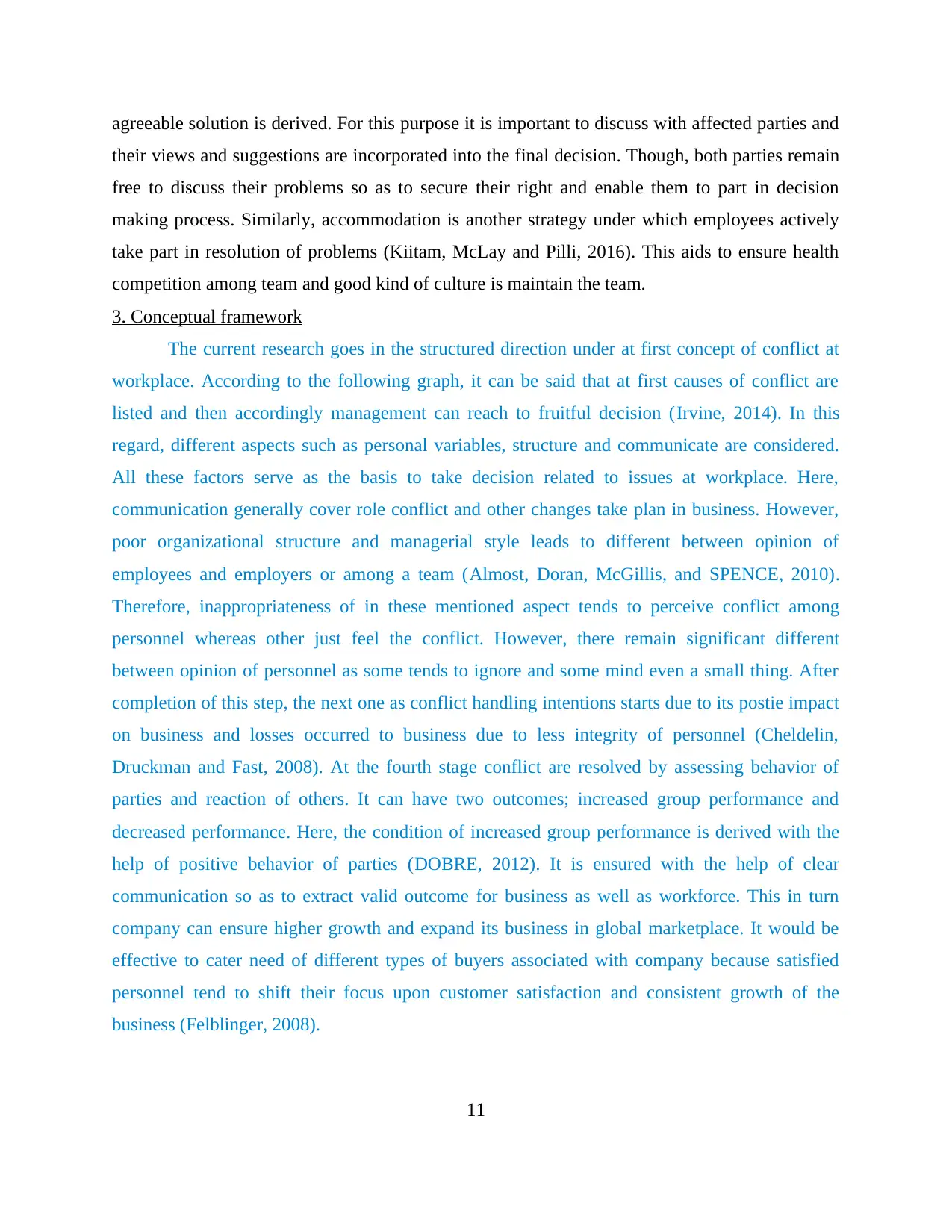
agreeable solution is derived. For this purpose it is important to discuss with affected parties and
their views and suggestions are incorporated into the final decision. Though, both parties remain
free to discuss their problems so as to secure their right and enable them to part in decision
making process. Similarly, accommodation is another strategy under which employees actively
take part in resolution of problems (Kiitam, McLay and Pilli, 2016). This aids to ensure health
competition among team and good kind of culture is maintain the team.
3. Conceptual framework
The current research goes in the structured direction under at first concept of conflict at
workplace. According to the following graph, it can be said that at first causes of conflict are
listed and then accordingly management can reach to fruitful decision (Irvine, 2014). In this
regard, different aspects such as personal variables, structure and communicate are considered.
All these factors serve as the basis to take decision related to issues at workplace. Here,
communication generally cover role conflict and other changes take plan in business. However,
poor organizational structure and managerial style leads to different between opinion of
employees and employers or among a team (Almost, Doran, McGillis, and SPENCE, 2010).
Therefore, inappropriateness of in these mentioned aspect tends to perceive conflict among
personnel whereas other just feel the conflict. However, there remain significant different
between opinion of personnel as some tends to ignore and some mind even a small thing. After
completion of this step, the next one as conflict handling intentions starts due to its postie impact
on business and losses occurred to business due to less integrity of personnel (Cheldelin,
Druckman and Fast, 2008). At the fourth stage conflict are resolved by assessing behavior of
parties and reaction of others. It can have two outcomes; increased group performance and
decreased performance. Here, the condition of increased group performance is derived with the
help of positive behavior of parties (DOBRE, 2012). It is ensured with the help of clear
communication so as to extract valid outcome for business as well as workforce. This in turn
company can ensure higher growth and expand its business in global marketplace. It would be
effective to cater need of different types of buyers associated with company because satisfied
personnel tend to shift their focus upon customer satisfaction and consistent growth of the
business (Felblinger, 2008).
11
their views and suggestions are incorporated into the final decision. Though, both parties remain
free to discuss their problems so as to secure their right and enable them to part in decision
making process. Similarly, accommodation is another strategy under which employees actively
take part in resolution of problems (Kiitam, McLay and Pilli, 2016). This aids to ensure health
competition among team and good kind of culture is maintain the team.
3. Conceptual framework
The current research goes in the structured direction under at first concept of conflict at
workplace. According to the following graph, it can be said that at first causes of conflict are
listed and then accordingly management can reach to fruitful decision (Irvine, 2014). In this
regard, different aspects such as personal variables, structure and communicate are considered.
All these factors serve as the basis to take decision related to issues at workplace. Here,
communication generally cover role conflict and other changes take plan in business. However,
poor organizational structure and managerial style leads to different between opinion of
employees and employers or among a team (Almost, Doran, McGillis, and SPENCE, 2010).
Therefore, inappropriateness of in these mentioned aspect tends to perceive conflict among
personnel whereas other just feel the conflict. However, there remain significant different
between opinion of personnel as some tends to ignore and some mind even a small thing. After
completion of this step, the next one as conflict handling intentions starts due to its postie impact
on business and losses occurred to business due to less integrity of personnel (Cheldelin,
Druckman and Fast, 2008). At the fourth stage conflict are resolved by assessing behavior of
parties and reaction of others. It can have two outcomes; increased group performance and
decreased performance. Here, the condition of increased group performance is derived with the
help of positive behavior of parties (DOBRE, 2012). It is ensured with the help of clear
communication so as to extract valid outcome for business as well as workforce. This in turn
company can ensure higher growth and expand its business in global marketplace. It would be
effective to cater need of different types of buyers associated with company because satisfied
personnel tend to shift their focus upon customer satisfaction and consistent growth of the
business (Felblinger, 2008).
11
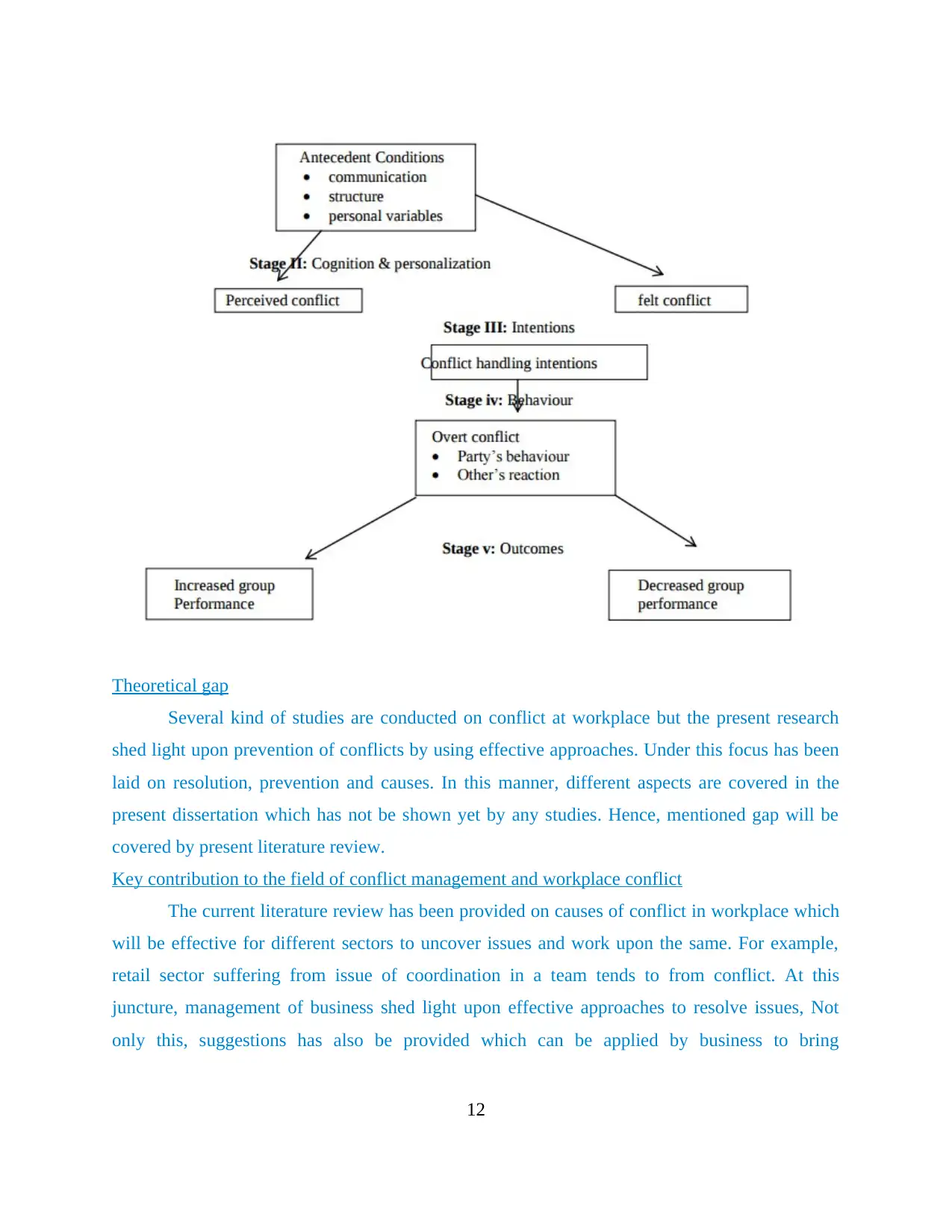
Theoretical gap
Several kind of studies are conducted on conflict at workplace but the present research
shed light upon prevention of conflicts by using effective approaches. Under this focus has been
laid on resolution, prevention and causes. In this manner, different aspects are covered in the
present dissertation which has not be shown yet by any studies. Hence, mentioned gap will be
covered by present literature review.
Key contribution to the field of conflict management and workplace conflict
The current literature review has been provided on causes of conflict in workplace which
will be effective for different sectors to uncover issues and work upon the same. For example,
retail sector suffering from issue of coordination in a team tends to from conflict. At this
juncture, management of business shed light upon effective approaches to resolve issues, Not
only this, suggestions has also be provided which can be applied by business to bring
12
Several kind of studies are conducted on conflict at workplace but the present research
shed light upon prevention of conflicts by using effective approaches. Under this focus has been
laid on resolution, prevention and causes. In this manner, different aspects are covered in the
present dissertation which has not be shown yet by any studies. Hence, mentioned gap will be
covered by present literature review.
Key contribution to the field of conflict management and workplace conflict
The current literature review has been provided on causes of conflict in workplace which
will be effective for different sectors to uncover issues and work upon the same. For example,
retail sector suffering from issue of coordination in a team tends to from conflict. At this
juncture, management of business shed light upon effective approaches to resolve issues, Not
only this, suggestions has also be provided which can be applied by business to bring
12

improvement in overall business scenario. However, current study will be helpful for those who
conducting their thesis in the same field, they can refer this as source of information while
collecting secondary data. In this manner, current study will be effective for different sectors as
well as other related businesses.
13
conducting their thesis in the same field, they can refer this as source of information while
collecting secondary data. In this manner, current study will be effective for different sectors as
well as other related businesses.
13
Paraphrase This Document
Need a fresh take? Get an instant paraphrase of this document with our AI Paraphraser

4. Designing own questionnaire
Questionnaire is considered as the most important part of the study through which
research collect primary information. The current research questionnaire consists of close ended
questions under which each question is supported by options. It facilitates to save the time and
provide variety of options for respondents to select as per their preferences and situation. With
the help of below mentioned questionnaire, scholar will be able to analyze the available
information so as to draw valid outcome. It proves to be effective to provide valuable
suggestions for the company and accordingly take corrective action in order to ensure long run
growth.
Name____________________
Gender
Male
Female
Age
18-25 Years
26-30 Years
31-35 Years
36 and above
1. Do you face conflict at workplace frequently?
Yes
No
Can't say
2. In your opinion what are the main causes of conflict?
Poor management
Work load
Bullying at work
Perceived discrimination
All of the above
3. According to you, who is responsible to manage the conflict?
Management
14
Questionnaire is considered as the most important part of the study through which
research collect primary information. The current research questionnaire consists of close ended
questions under which each question is supported by options. It facilitates to save the time and
provide variety of options for respondents to select as per their preferences and situation. With
the help of below mentioned questionnaire, scholar will be able to analyze the available
information so as to draw valid outcome. It proves to be effective to provide valuable
suggestions for the company and accordingly take corrective action in order to ensure long run
growth.
Name____________________
Gender
Male
Female
Age
18-25 Years
26-30 Years
31-35 Years
36 and above
1. Do you face conflict at workplace frequently?
Yes
No
Can't say
2. In your opinion what are the main causes of conflict?
Poor management
Work load
Bullying at work
Perceived discrimination
All of the above
3. According to you, who is responsible to manage the conflict?
Management
14
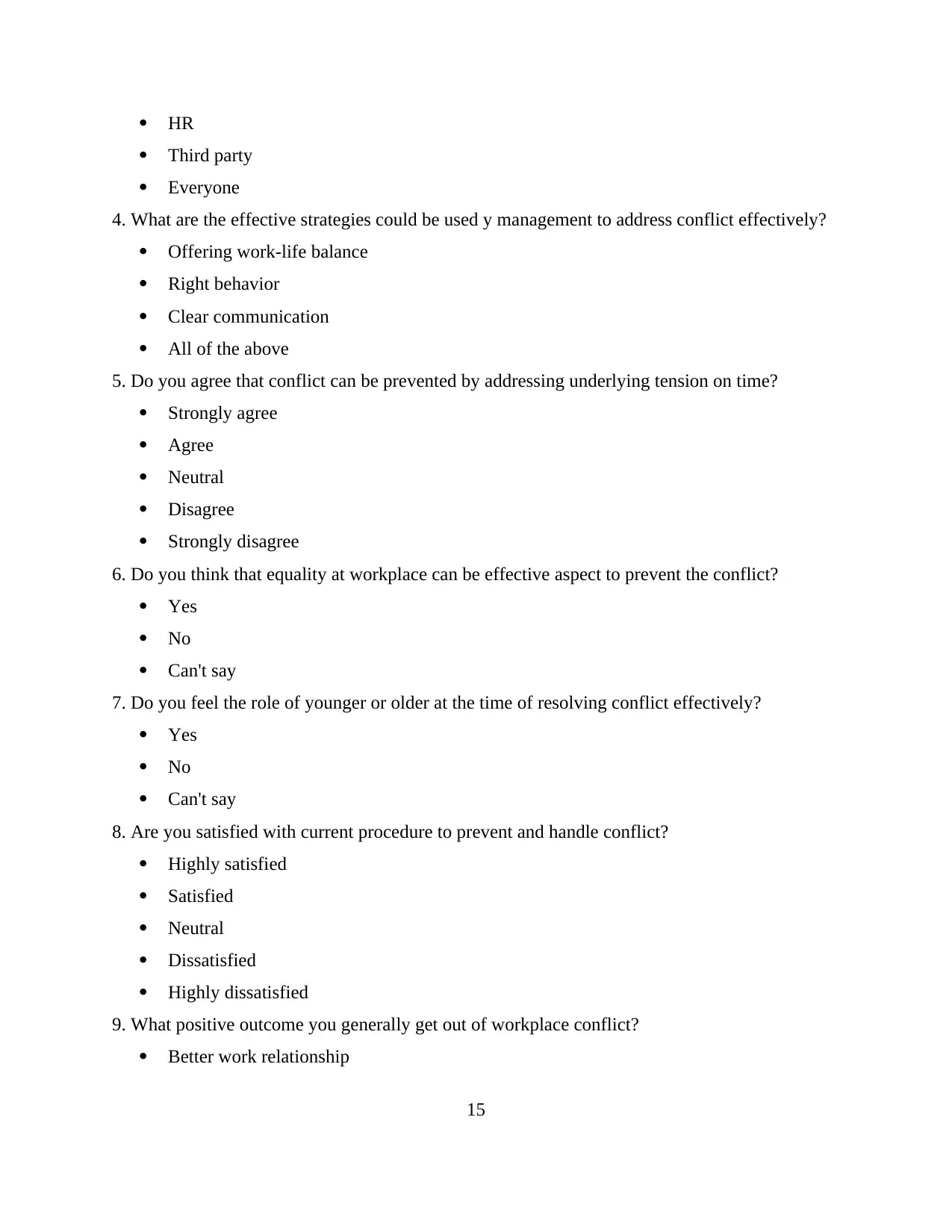
HR
Third party
Everyone
4. What are the effective strategies could be used y management to address conflict effectively?
Offering work-life balance
Right behavior
Clear communication
All of the above
5. Do you agree that conflict can be prevented by addressing underlying tension on time?
Strongly agree
Agree
Neutral
Disagree
Strongly disagree
6. Do you think that equality at workplace can be effective aspect to prevent the conflict?
Yes
No
Can't say
7. Do you feel the role of younger or older at the time of resolving conflict effectively?
Yes
No
Can't say
8. Are you satisfied with current procedure to prevent and handle conflict?
Highly satisfied
Satisfied
Neutral
Dissatisfied
Highly dissatisfied
9. What positive outcome you generally get out of workplace conflict?
Better work relationship
15
Third party
Everyone
4. What are the effective strategies could be used y management to address conflict effectively?
Offering work-life balance
Right behavior
Clear communication
All of the above
5. Do you agree that conflict can be prevented by addressing underlying tension on time?
Strongly agree
Agree
Neutral
Disagree
Strongly disagree
6. Do you think that equality at workplace can be effective aspect to prevent the conflict?
Yes
No
Can't say
7. Do you feel the role of younger or older at the time of resolving conflict effectively?
Yes
No
Can't say
8. Are you satisfied with current procedure to prevent and handle conflict?
Highly satisfied
Satisfied
Neutral
Dissatisfied
Highly dissatisfied
9. What positive outcome you generally get out of workplace conflict?
Better work relationship
15
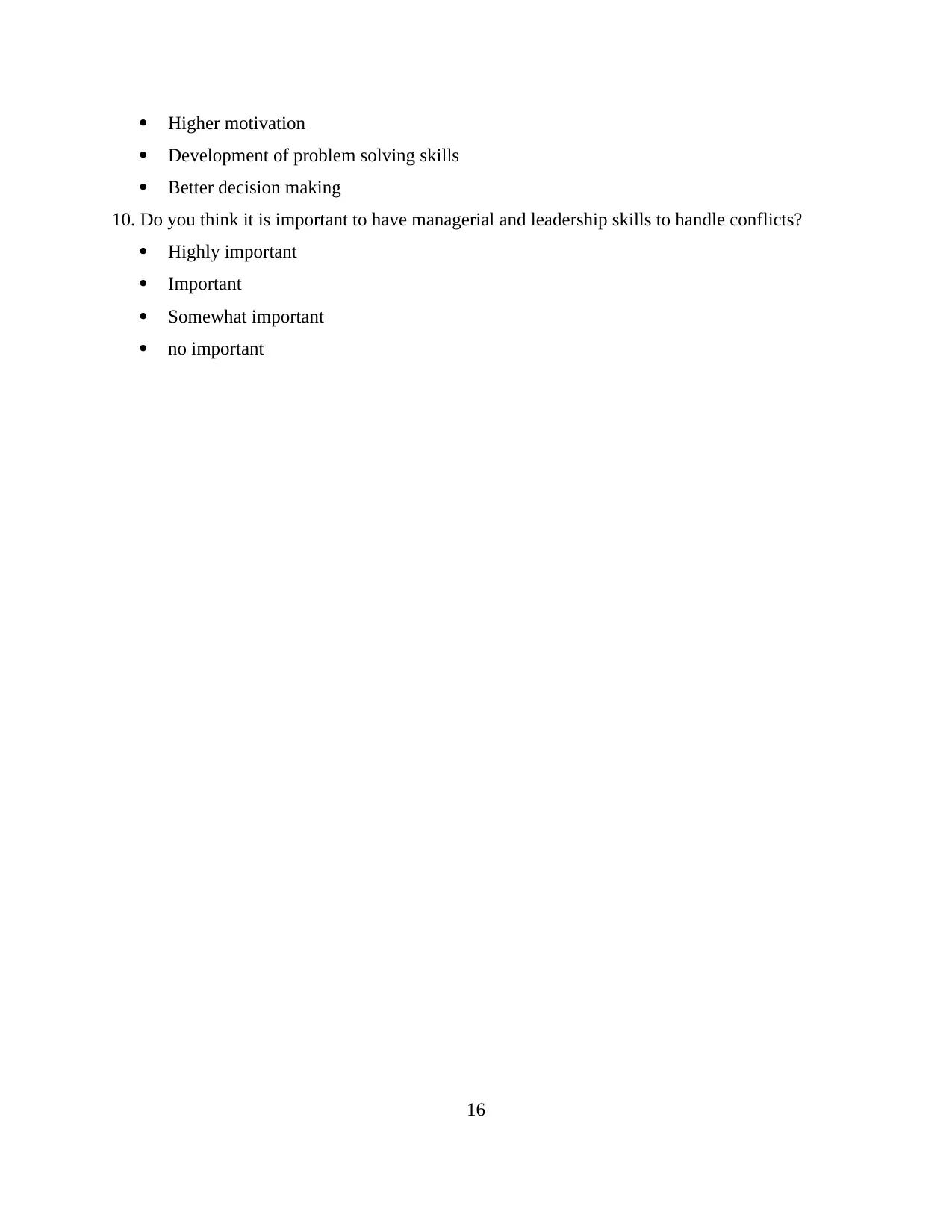
Higher motivation
Development of problem solving skills
Better decision making
10. Do you think it is important to have managerial and leadership skills to handle conflicts?
Highly important
Important
Somewhat important
no important
16
Development of problem solving skills
Better decision making
10. Do you think it is important to have managerial and leadership skills to handle conflicts?
Highly important
Important
Somewhat important
no important
16
Secure Best Marks with AI Grader
Need help grading? Try our AI Grader for instant feedback on your assignments.
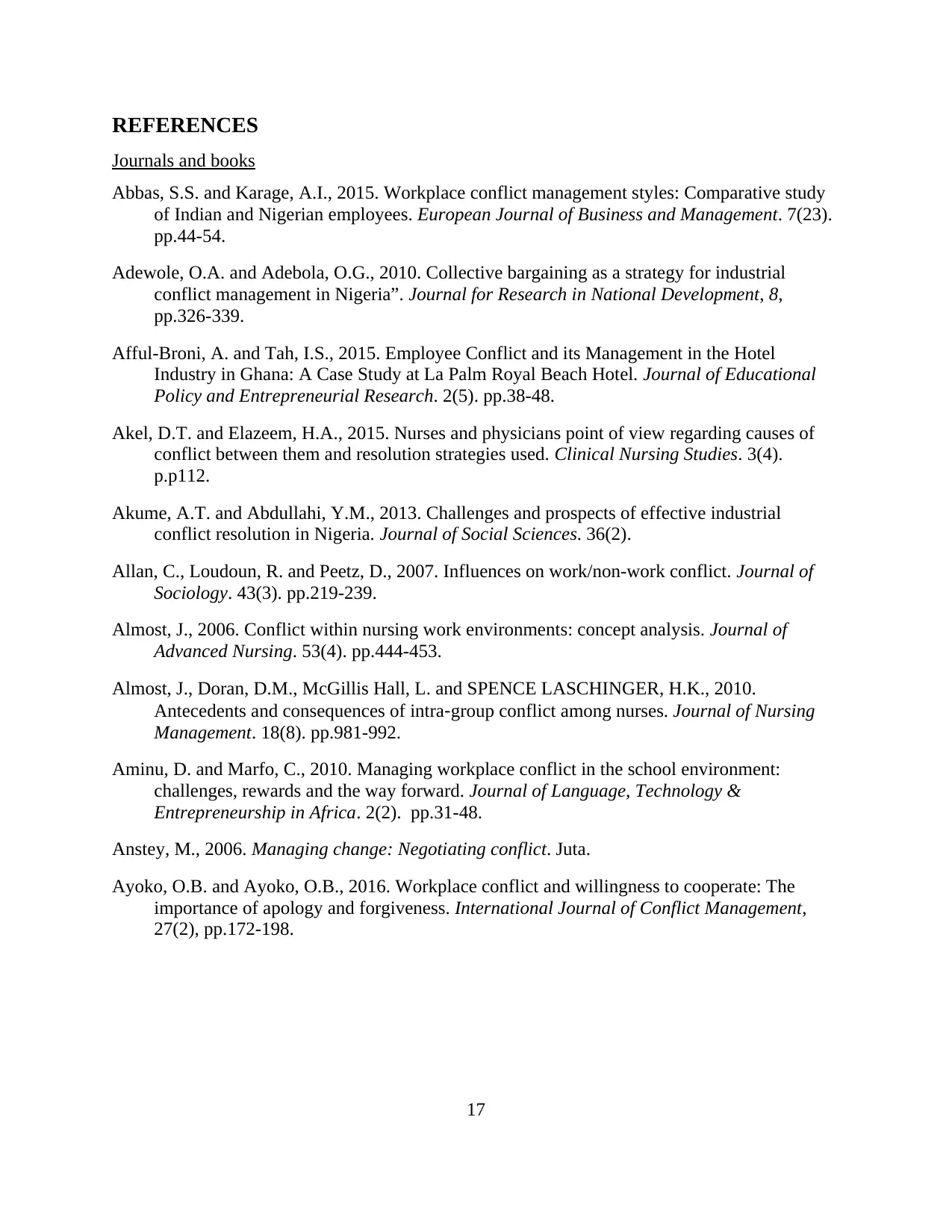
REFERENCES
Journals and books
Abbas, S.S. and Karage, A.I., 2015. Workplace conflict management styles: Comparative study
of Indian and Nigerian employees. European Journal of Business and Management. 7(23).
pp.44-54.
Adewole, O.A. and Adebola, O.G., 2010. Collective bargaining as a strategy for industrial
conflict management in Nigeria”. Journal for Research in National Development, 8,
pp.326-339.
Afful-Broni, A. and Tah, I.S., 2015. Employee Conflict and its Management in the Hotel
Industry in Ghana: A Case Study at La Palm Royal Beach Hotel. Journal of Educational
Policy and Entrepreneurial Research. 2(5). pp.38-48.
Akel, D.T. and Elazeem, H.A., 2015. Nurses and physicians point of view regarding causes of
conflict between them and resolution strategies used. Clinical Nursing Studies. 3(4).
p.p112.
Akume, A.T. and Abdullahi, Y.M., 2013. Challenges and prospects of effective industrial
conflict resolution in Nigeria. Journal of Social Sciences. 36(2).
Allan, C., Loudoun, R. and Peetz, D., 2007. Influences on work/non-work conflict. Journal of
Sociology. 43(3). pp.219-239.
Almost, J., 2006. Conflict within nursing work environments: concept analysis. Journal of
Advanced Nursing. 53(4). pp.444-453.
Almost, J., Doran, D.M., McGillis Hall, L. and SPENCE LASCHINGER, H.K., 2010.
Antecedents and consequences of intra‐group conflict among nurses. Journal of Nursing
Management. 18(8). pp.981-992.
Aminu, D. and Marfo, C., 2010. Managing workplace conflict in the school environment:
challenges, rewards and the way forward. Journal of Language, Technology &
Entrepreneurship in Africa. 2(2). pp.31-48.
Anstey, M., 2006. Managing change: Negotiating conflict. Juta.
Ayoko, O.B. and Ayoko, O.B., 2016. Workplace conflict and willingness to cooperate: The
importance of apology and forgiveness. International Journal of Conflict Management,
27(2), pp.172-198.
17
Journals and books
Abbas, S.S. and Karage, A.I., 2015. Workplace conflict management styles: Comparative study
of Indian and Nigerian employees. European Journal of Business and Management. 7(23).
pp.44-54.
Adewole, O.A. and Adebola, O.G., 2010. Collective bargaining as a strategy for industrial
conflict management in Nigeria”. Journal for Research in National Development, 8,
pp.326-339.
Afful-Broni, A. and Tah, I.S., 2015. Employee Conflict and its Management in the Hotel
Industry in Ghana: A Case Study at La Palm Royal Beach Hotel. Journal of Educational
Policy and Entrepreneurial Research. 2(5). pp.38-48.
Akel, D.T. and Elazeem, H.A., 2015. Nurses and physicians point of view regarding causes of
conflict between them and resolution strategies used. Clinical Nursing Studies. 3(4).
p.p112.
Akume, A.T. and Abdullahi, Y.M., 2013. Challenges and prospects of effective industrial
conflict resolution in Nigeria. Journal of Social Sciences. 36(2).
Allan, C., Loudoun, R. and Peetz, D., 2007. Influences on work/non-work conflict. Journal of
Sociology. 43(3). pp.219-239.
Almost, J., 2006. Conflict within nursing work environments: concept analysis. Journal of
Advanced Nursing. 53(4). pp.444-453.
Almost, J., Doran, D.M., McGillis Hall, L. and SPENCE LASCHINGER, H.K., 2010.
Antecedents and consequences of intra‐group conflict among nurses. Journal of Nursing
Management. 18(8). pp.981-992.
Aminu, D. and Marfo, C., 2010. Managing workplace conflict in the school environment:
challenges, rewards and the way forward. Journal of Language, Technology &
Entrepreneurship in Africa. 2(2). pp.31-48.
Anstey, M., 2006. Managing change: Negotiating conflict. Juta.
Ayoko, O.B. and Ayoko, O.B., 2016. Workplace conflict and willingness to cooperate: The
importance of apology and forgiveness. International Journal of Conflict Management,
27(2), pp.172-198.
17

Ayoko, O.B., 2007. Communication openness, conflict events and reactions to conflict in
culturally diverse workgroups. Cross Cultural Management: An International Journal.
14(2). pp.105-124.
Ayoko, O.B., Callan, V.J. and Härtel, C.E., 2008. The influence of team emotional intelligence
climate on conflict and team members' reactions to conflict. Small Group Research. 39(2).
pp.121-149.
Baillien, E. and De Witte, H., 2009. Why is organizational change related to workplace bullying?
Role conflict and job insecurity as mediators. Economic and Industrial Democracy. 30(3).
pp.348-371.
Baillien, E. and De Witte, H., 2010. The relationship between the occurrence of conflicts in the
work unit, the conflict management styles in the work unit and workplace bullying.
Psychologica Belgica, 49(4)
Baillien, E., Bollen, K., Euwema, M. and De Witte, H., 2014. Conflicts and conflict management
styles as precursors of workplace bullying: A two-wave longitudinal study. European
Journal of Work and Organizational Psychology. 23(4). pp.511-524.
Baillien, E., Camps, J., Van den Broeck, A., Stouten, J., Godderis, L., Sercu, M. and De Witte,
H., 2015. An eye for an eye will make the whole world blind: conflict escalation into
workplace bullying and the role of distributive conflict behavior. Journal of Business
Ethics, pp.1-15.
Baillien, E., Neyens, I., De Witte, H. and De Cuyper, N., 2009. A qualitative study on the
development of workplace bullying: Towards a three way model. Journal of Community &
Applied Social Psychology.19(1). pp.1-16.
Bakhare, R., 2010. Conflict Management. speaks..., p.41.
Barling, J., Dupré, K.E. and Kelloway, E.K., 2009. Predicting workplace aggression and
violence. Annual review of psychology. 60. pp.671-692.
Beehr, T.A., 2014. Psychological stress in the workplace (Psychology revivals). Routledge.
Bell, C. and Song, F., 2005. Emotions in the conflict process: An application of the cognitive
appraisal model of emotions to conflict management. International Journal of Conflict
Management. 16(1). pp.30-54.
Bennett, T., 2013. Do union-management learning partnerships reduce workplace conflict?.
Employee Relations. 36(1). pp.17-32.
Bingham, L.B., Hallberlin, C.J., Walker, D.A. and Chung, W.T., 2009. Dispute system design
and justice in employment dispute resolution: Mediation at the workplace. Harv. Negot. L.
Rev.. 14. p.1.
Blanchard, J.M.F. and Shen, S. eds., 2015. Conflict and Cooperation in Sino-US Relations:
Change and Continuity, Causes and Cures. Routledge.
18
culturally diverse workgroups. Cross Cultural Management: An International Journal.
14(2). pp.105-124.
Ayoko, O.B., Callan, V.J. and Härtel, C.E., 2008. The influence of team emotional intelligence
climate on conflict and team members' reactions to conflict. Small Group Research. 39(2).
pp.121-149.
Baillien, E. and De Witte, H., 2009. Why is organizational change related to workplace bullying?
Role conflict and job insecurity as mediators. Economic and Industrial Democracy. 30(3).
pp.348-371.
Baillien, E. and De Witte, H., 2010. The relationship between the occurrence of conflicts in the
work unit, the conflict management styles in the work unit and workplace bullying.
Psychologica Belgica, 49(4)
Baillien, E., Bollen, K., Euwema, M. and De Witte, H., 2014. Conflicts and conflict management
styles as precursors of workplace bullying: A two-wave longitudinal study. European
Journal of Work and Organizational Psychology. 23(4). pp.511-524.
Baillien, E., Camps, J., Van den Broeck, A., Stouten, J., Godderis, L., Sercu, M. and De Witte,
H., 2015. An eye for an eye will make the whole world blind: conflict escalation into
workplace bullying and the role of distributive conflict behavior. Journal of Business
Ethics, pp.1-15.
Baillien, E., Neyens, I., De Witte, H. and De Cuyper, N., 2009. A qualitative study on the
development of workplace bullying: Towards a three way model. Journal of Community &
Applied Social Psychology.19(1). pp.1-16.
Bakhare, R., 2010. Conflict Management. speaks..., p.41.
Barling, J., Dupré, K.E. and Kelloway, E.K., 2009. Predicting workplace aggression and
violence. Annual review of psychology. 60. pp.671-692.
Beehr, T.A., 2014. Psychological stress in the workplace (Psychology revivals). Routledge.
Bell, C. and Song, F., 2005. Emotions in the conflict process: An application of the cognitive
appraisal model of emotions to conflict management. International Journal of Conflict
Management. 16(1). pp.30-54.
Bennett, T., 2013. Do union-management learning partnerships reduce workplace conflict?.
Employee Relations. 36(1). pp.17-32.
Bingham, L.B., Hallberlin, C.J., Walker, D.A. and Chung, W.T., 2009. Dispute system design
and justice in employment dispute resolution: Mediation at the workplace. Harv. Negot. L.
Rev.. 14. p.1.
Blanchard, J.M.F. and Shen, S. eds., 2015. Conflict and Cooperation in Sino-US Relations:
Change and Continuity, Causes and Cures. Routledge.
18
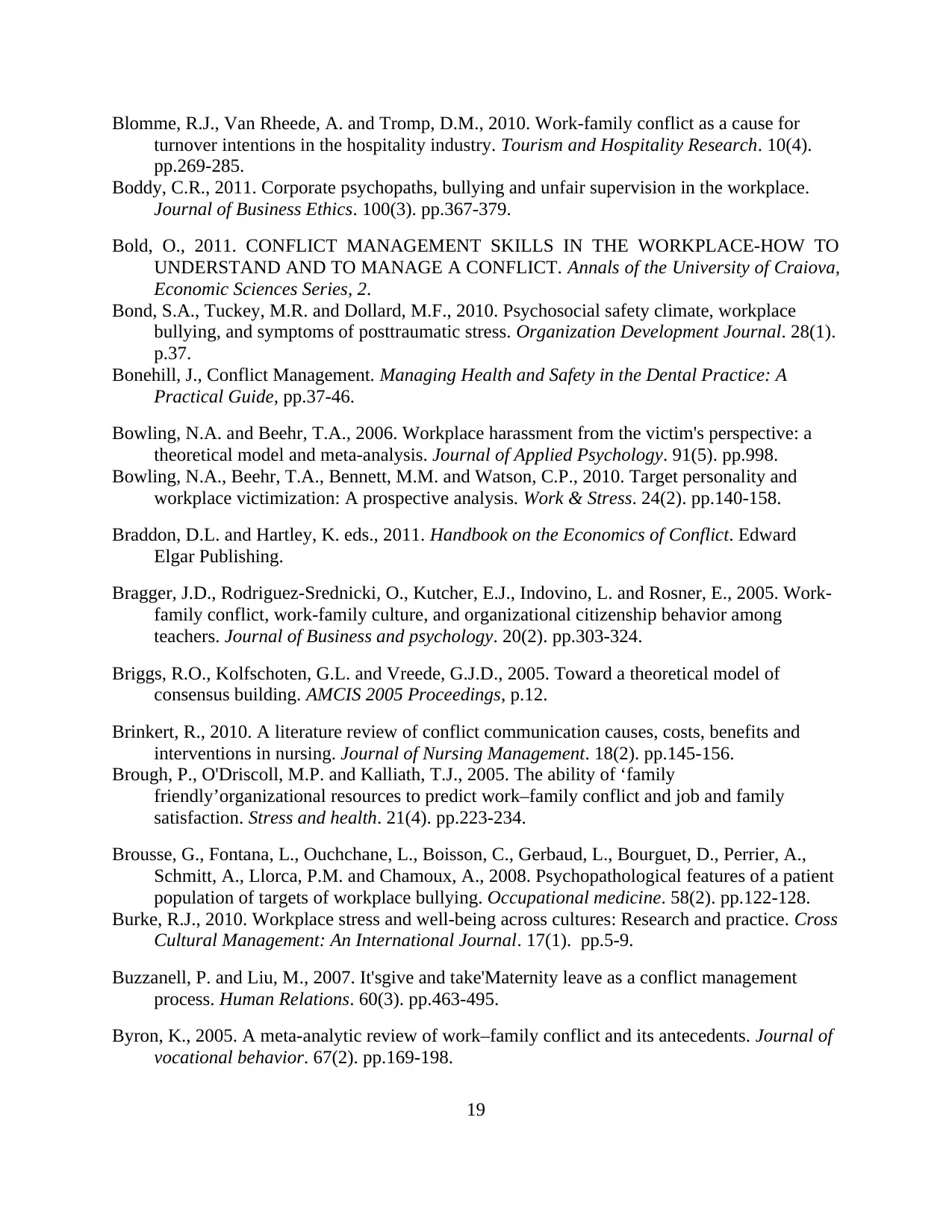
Blomme, R.J., Van Rheede, A. and Tromp, D.M., 2010. Work-family conflict as a cause for
turnover intentions in the hospitality industry. Tourism and Hospitality Research. 10(4).
pp.269-285.
Boddy, C.R., 2011. Corporate psychopaths, bullying and unfair supervision in the workplace.
Journal of Business Ethics. 100(3). pp.367-379.
Bold, O., 2011. CONFLICT MANAGEMENT SKILLS IN THE WORKPLACE-HOW TO
UNDERSTAND AND TO MANAGE A CONFLICT. Annals of the University of Craiova,
Economic Sciences Series, 2.
Bond, S.A., Tuckey, M.R. and Dollard, M.F., 2010. Psychosocial safety climate, workplace
bullying, and symptoms of posttraumatic stress. Organization Development Journal. 28(1).
p.37.
Bonehill, J., Conflict Management. Managing Health and Safety in the Dental Practice: A
Practical Guide, pp.37-46.
Bowling, N.A. and Beehr, T.A., 2006. Workplace harassment from the victim's perspective: a
theoretical model and meta-analysis. Journal of Applied Psychology. 91(5). pp.998.
Bowling, N.A., Beehr, T.A., Bennett, M.M. and Watson, C.P., 2010. Target personality and
workplace victimization: A prospective analysis. Work & Stress. 24(2). pp.140-158.
Braddon, D.L. and Hartley, K. eds., 2011. Handbook on the Economics of Conflict. Edward
Elgar Publishing.
Bragger, J.D., Rodriguez-Srednicki, O., Kutcher, E.J., Indovino, L. and Rosner, E., 2005. Work-
family conflict, work-family culture, and organizational citizenship behavior among
teachers. Journal of Business and psychology. 20(2). pp.303-324.
Briggs, R.O., Kolfschoten, G.L. and Vreede, G.J.D., 2005. Toward a theoretical model of
consensus building. AMCIS 2005 Proceedings, p.12.
Brinkert, R., 2010. A literature review of conflict communication causes, costs, benefits and
interventions in nursing. Journal of Nursing Management. 18(2). pp.145-156.
Brough, P., O'Driscoll, M.P. and Kalliath, T.J., 2005. The ability of ‘family
friendly’organizational resources to predict work–family conflict and job and family
satisfaction. Stress and health. 21(4). pp.223-234.
Brousse, G., Fontana, L., Ouchchane, L., Boisson, C., Gerbaud, L., Bourguet, D., Perrier, A.,
Schmitt, A., Llorca, P.M. and Chamoux, A., 2008. Psychopathological features of a patient
population of targets of workplace bullying. Occupational medicine. 58(2). pp.122-128.
Burke, R.J., 2010. Workplace stress and well-being across cultures: Research and practice. Cross
Cultural Management: An International Journal. 17(1). pp.5-9.
Buzzanell, P. and Liu, M., 2007. It'sgive and take'Maternity leave as a conflict management
process. Human Relations. 60(3). pp.463-495.
Byron, K., 2005. A meta-analytic review of work–family conflict and its antecedents. Journal of
vocational behavior. 67(2). pp.169-198.
19
turnover intentions in the hospitality industry. Tourism and Hospitality Research. 10(4).
pp.269-285.
Boddy, C.R., 2011. Corporate psychopaths, bullying and unfair supervision in the workplace.
Journal of Business Ethics. 100(3). pp.367-379.
Bold, O., 2011. CONFLICT MANAGEMENT SKILLS IN THE WORKPLACE-HOW TO
UNDERSTAND AND TO MANAGE A CONFLICT. Annals of the University of Craiova,
Economic Sciences Series, 2.
Bond, S.A., Tuckey, M.R. and Dollard, M.F., 2010. Psychosocial safety climate, workplace
bullying, and symptoms of posttraumatic stress. Organization Development Journal. 28(1).
p.37.
Bonehill, J., Conflict Management. Managing Health and Safety in the Dental Practice: A
Practical Guide, pp.37-46.
Bowling, N.A. and Beehr, T.A., 2006. Workplace harassment from the victim's perspective: a
theoretical model and meta-analysis. Journal of Applied Psychology. 91(5). pp.998.
Bowling, N.A., Beehr, T.A., Bennett, M.M. and Watson, C.P., 2010. Target personality and
workplace victimization: A prospective analysis. Work & Stress. 24(2). pp.140-158.
Braddon, D.L. and Hartley, K. eds., 2011. Handbook on the Economics of Conflict. Edward
Elgar Publishing.
Bragger, J.D., Rodriguez-Srednicki, O., Kutcher, E.J., Indovino, L. and Rosner, E., 2005. Work-
family conflict, work-family culture, and organizational citizenship behavior among
teachers. Journal of Business and psychology. 20(2). pp.303-324.
Briggs, R.O., Kolfschoten, G.L. and Vreede, G.J.D., 2005. Toward a theoretical model of
consensus building. AMCIS 2005 Proceedings, p.12.
Brinkert, R., 2010. A literature review of conflict communication causes, costs, benefits and
interventions in nursing. Journal of Nursing Management. 18(2). pp.145-156.
Brough, P., O'Driscoll, M.P. and Kalliath, T.J., 2005. The ability of ‘family
friendly’organizational resources to predict work–family conflict and job and family
satisfaction. Stress and health. 21(4). pp.223-234.
Brousse, G., Fontana, L., Ouchchane, L., Boisson, C., Gerbaud, L., Bourguet, D., Perrier, A.,
Schmitt, A., Llorca, P.M. and Chamoux, A., 2008. Psychopathological features of a patient
population of targets of workplace bullying. Occupational medicine. 58(2). pp.122-128.
Burke, R.J., 2010. Workplace stress and well-being across cultures: Research and practice. Cross
Cultural Management: An International Journal. 17(1). pp.5-9.
Buzzanell, P. and Liu, M., 2007. It'sgive and take'Maternity leave as a conflict management
process. Human Relations. 60(3). pp.463-495.
Byron, K., 2005. A meta-analytic review of work–family conflict and its antecedents. Journal of
vocational behavior. 67(2). pp.169-198.
19
Paraphrase This Document
Need a fresh take? Get an instant paraphrase of this document with our AI Paraphraser
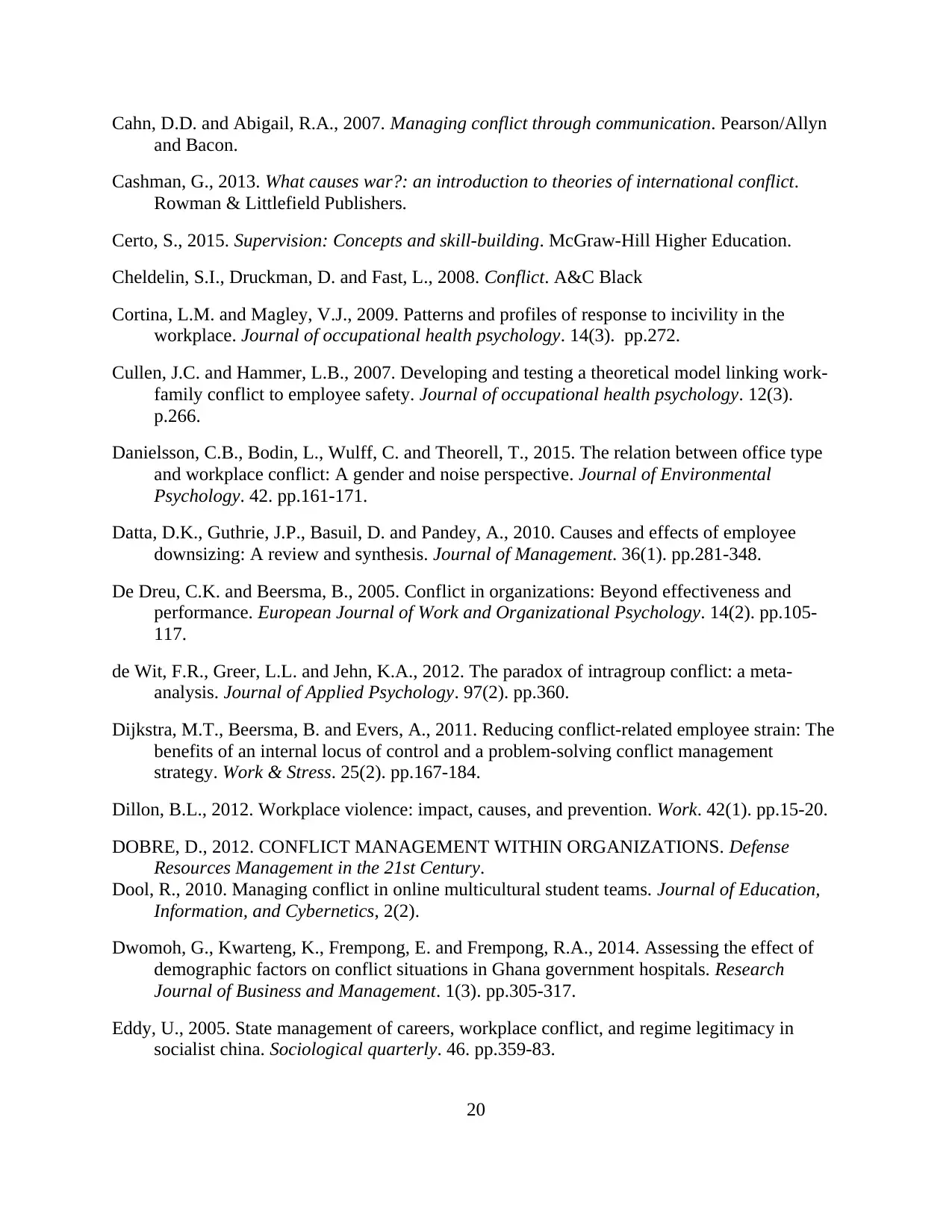
Cahn, D.D. and Abigail, R.A., 2007. Managing conflict through communication. Pearson/Allyn
and Bacon.
Cashman, G., 2013. What causes war?: an introduction to theories of international conflict.
Rowman & Littlefield Publishers.
Certo, S., 2015. Supervision: Concepts and skill-building. McGraw-Hill Higher Education.
Cheldelin, S.I., Druckman, D. and Fast, L., 2008. Conflict. A&C Black
Cortina, L.M. and Magley, V.J., 2009. Patterns and profiles of response to incivility in the
workplace. Journal of occupational health psychology. 14(3). pp.272.
Cullen, J.C. and Hammer, L.B., 2007. Developing and testing a theoretical model linking work-
family conflict to employee safety. Journal of occupational health psychology. 12(3).
p.266.
Danielsson, C.B., Bodin, L., Wulff, C. and Theorell, T., 2015. The relation between office type
and workplace conflict: A gender and noise perspective. Journal of Environmental
Psychology. 42. pp.161-171.
Datta, D.K., Guthrie, J.P., Basuil, D. and Pandey, A., 2010. Causes and effects of employee
downsizing: A review and synthesis. Journal of Management. 36(1). pp.281-348.
De Dreu, C.K. and Beersma, B., 2005. Conflict in organizations: Beyond effectiveness and
performance. European Journal of Work and Organizational Psychology. 14(2). pp.105-
117.
de Wit, F.R., Greer, L.L. and Jehn, K.A., 2012. The paradox of intragroup conflict: a meta-
analysis. Journal of Applied Psychology. 97(2). pp.360.
Dijkstra, M.T., Beersma, B. and Evers, A., 2011. Reducing conflict-related employee strain: The
benefits of an internal locus of control and a problem-solving conflict management
strategy. Work & Stress. 25(2). pp.167-184.
Dillon, B.L., 2012. Workplace violence: impact, causes, and prevention. Work. 42(1). pp.15-20.
DOBRE, D., 2012. CONFLICT MANAGEMENT WITHIN ORGANIZATIONS. Defense
Resources Management in the 21st Century.
Dool, R., 2010. Managing conflict in online multicultural student teams. Journal of Education,
Information, and Cybernetics, 2(2).
Dwomoh, G., Kwarteng, K., Frempong, E. and Frempong, R.A., 2014. Assessing the effect of
demographic factors on conflict situations in Ghana government hospitals. Research
Journal of Business and Management. 1(3). pp.305-317.
Eddy, U., 2005. State management of careers, workplace conflict, and regime legitimacy in
socialist china. Sociological quarterly. 46. pp.359-83.
20
and Bacon.
Cashman, G., 2013. What causes war?: an introduction to theories of international conflict.
Rowman & Littlefield Publishers.
Certo, S., 2015. Supervision: Concepts and skill-building. McGraw-Hill Higher Education.
Cheldelin, S.I., Druckman, D. and Fast, L., 2008. Conflict. A&C Black
Cortina, L.M. and Magley, V.J., 2009. Patterns and profiles of response to incivility in the
workplace. Journal of occupational health psychology. 14(3). pp.272.
Cullen, J.C. and Hammer, L.B., 2007. Developing and testing a theoretical model linking work-
family conflict to employee safety. Journal of occupational health psychology. 12(3).
p.266.
Danielsson, C.B., Bodin, L., Wulff, C. and Theorell, T., 2015. The relation between office type
and workplace conflict: A gender and noise perspective. Journal of Environmental
Psychology. 42. pp.161-171.
Datta, D.K., Guthrie, J.P., Basuil, D. and Pandey, A., 2010. Causes and effects of employee
downsizing: A review and synthesis. Journal of Management. 36(1). pp.281-348.
De Dreu, C.K. and Beersma, B., 2005. Conflict in organizations: Beyond effectiveness and
performance. European Journal of Work and Organizational Psychology. 14(2). pp.105-
117.
de Wit, F.R., Greer, L.L. and Jehn, K.A., 2012. The paradox of intragroup conflict: a meta-
analysis. Journal of Applied Psychology. 97(2). pp.360.
Dijkstra, M.T., Beersma, B. and Evers, A., 2011. Reducing conflict-related employee strain: The
benefits of an internal locus of control and a problem-solving conflict management
strategy. Work & Stress. 25(2). pp.167-184.
Dillon, B.L., 2012. Workplace violence: impact, causes, and prevention. Work. 42(1). pp.15-20.
DOBRE, D., 2012. CONFLICT MANAGEMENT WITHIN ORGANIZATIONS. Defense
Resources Management in the 21st Century.
Dool, R., 2010. Managing conflict in online multicultural student teams. Journal of Education,
Information, and Cybernetics, 2(2).
Dwomoh, G., Kwarteng, K., Frempong, E. and Frempong, R.A., 2014. Assessing the effect of
demographic factors on conflict situations in Ghana government hospitals. Research
Journal of Business and Management. 1(3). pp.305-317.
Eddy, U., 2005. State management of careers, workplace conflict, and regime legitimacy in
socialist china. Sociological quarterly. 46. pp.359-83.
20

Efe, S.Y. and Ayaz, S., 2010. Mobbing against nurses in the workplace in Turkey. International
nursing review. 57(3). pp.328-334.
Egels-Zandén, N. and Hyllman, P., 2007. Evaluating strategies for negotiating workers’ rights in
transnational corporations: The effects of codes of conduct and global agreements on
workplace democracy. Journal of Business Ethics. 76(2). pp.207-223.
Einarsen, S., Hoel, H., Zapf, D. and Cooper, C. eds., 2010. Bullying and harassment in the
workplace: Developments in theory, research, and practice. Crc Press.
Falconer, H. and Bagshaw, M. eds., 2009. irs Managing Conflict in the Workplace. Routledge.
Farrell, G.A., Bobrowski, C. and Bobrowski, P., 2006. Scoping workplace aggression in nursing:
findings from an Australian study. Journal of advanced nursing. 55(6). pp.778-787
Felblinger, D.M., 2008. Incivility and bullying in the workplace and nurses’ shame responses.
Journal of Obstetric, Gynecologic, & Neonatal Nursing .37(2). pp.234-242.
Forth, J. and Dix, G., 2016. Exploring the Nature and Extent of Workplace Conflict. In
Reframing Resolution . Palgrave Macmillan UK.
Fraher, A.L., 2015, January. Intergenerational Conflict at US Airlines: An Unresolved Oedipal
Complex?. In Academy of Management Proceedings. Academy of Management.
Frazer, L., Weaven, S., Giddings, J. and Grace, D., 2012. What went wrong? Franchisors and
franchisees disclose the causes of conflict in franchising. Qualitative Market Research: An
International Journal. 15(1). pp.87-103.
Furlong, G.T., 2010. The conflict resolution toolbox: Models and maps for analyzing,
diagnosing, and resolving conflict. John Wiley & Sons.
George, G.E., Miroga, J.B. and Omweri, A.N., 2013. Organizational conflict management
strategies on employee job satisfaction: A case study of Nzoia Sugar Company.
Giebels, E. and Janssen, O., 2005. Conflict stress and reduced well-being at work: The buffering
effect of third-party help. European Journal of Work and Organizational Psychology.
14(2). pp.137-155.
Gifford, J., Gould, M., Latreille, P. and Urwin, P., 2016. Workplace Conflict: Who, Where,
When, and Why?. In Reframing Resolution .Palgrave Macmillan UK.
Gilin Oore, D., Leiter, M.P. and LeBlanc, D.E., 2015. Individual and organizational factors
promoting successful responses to workplace conflict. Canadian Psychology/Psychologie
canadienne. 56(3). pp.301.
Glasø, L., Matthiesen, S.B., Nielsen, M.B. and Einarsen, S., 2007. Do targets of workplace
bullying portray a general victim personality profile?. Scandinavian journal of psychology.
48(4). pp.313-319.
21
nursing review. 57(3). pp.328-334.
Egels-Zandén, N. and Hyllman, P., 2007. Evaluating strategies for negotiating workers’ rights in
transnational corporations: The effects of codes of conduct and global agreements on
workplace democracy. Journal of Business Ethics. 76(2). pp.207-223.
Einarsen, S., Hoel, H., Zapf, D. and Cooper, C. eds., 2010. Bullying and harassment in the
workplace: Developments in theory, research, and practice. Crc Press.
Falconer, H. and Bagshaw, M. eds., 2009. irs Managing Conflict in the Workplace. Routledge.
Farrell, G.A., Bobrowski, C. and Bobrowski, P., 2006. Scoping workplace aggression in nursing:
findings from an Australian study. Journal of advanced nursing. 55(6). pp.778-787
Felblinger, D.M., 2008. Incivility and bullying in the workplace and nurses’ shame responses.
Journal of Obstetric, Gynecologic, & Neonatal Nursing .37(2). pp.234-242.
Forth, J. and Dix, G., 2016. Exploring the Nature and Extent of Workplace Conflict. In
Reframing Resolution . Palgrave Macmillan UK.
Fraher, A.L., 2015, January. Intergenerational Conflict at US Airlines: An Unresolved Oedipal
Complex?. In Academy of Management Proceedings. Academy of Management.
Frazer, L., Weaven, S., Giddings, J. and Grace, D., 2012. What went wrong? Franchisors and
franchisees disclose the causes of conflict in franchising. Qualitative Market Research: An
International Journal. 15(1). pp.87-103.
Furlong, G.T., 2010. The conflict resolution toolbox: Models and maps for analyzing,
diagnosing, and resolving conflict. John Wiley & Sons.
George, G.E., Miroga, J.B. and Omweri, A.N., 2013. Organizational conflict management
strategies on employee job satisfaction: A case study of Nzoia Sugar Company.
Giebels, E. and Janssen, O., 2005. Conflict stress and reduced well-being at work: The buffering
effect of third-party help. European Journal of Work and Organizational Psychology.
14(2). pp.137-155.
Gifford, J., Gould, M., Latreille, P. and Urwin, P., 2016. Workplace Conflict: Who, Where,
When, and Why?. In Reframing Resolution .Palgrave Macmillan UK.
Gilin Oore, D., Leiter, M.P. and LeBlanc, D.E., 2015. Individual and organizational factors
promoting successful responses to workplace conflict. Canadian Psychology/Psychologie
canadienne. 56(3). pp.301.
Glasø, L., Matthiesen, S.B., Nielsen, M.B. and Einarsen, S., 2007. Do targets of workplace
bullying portray a general victim personality profile?. Scandinavian journal of psychology.
48(4). pp.313-319.
21
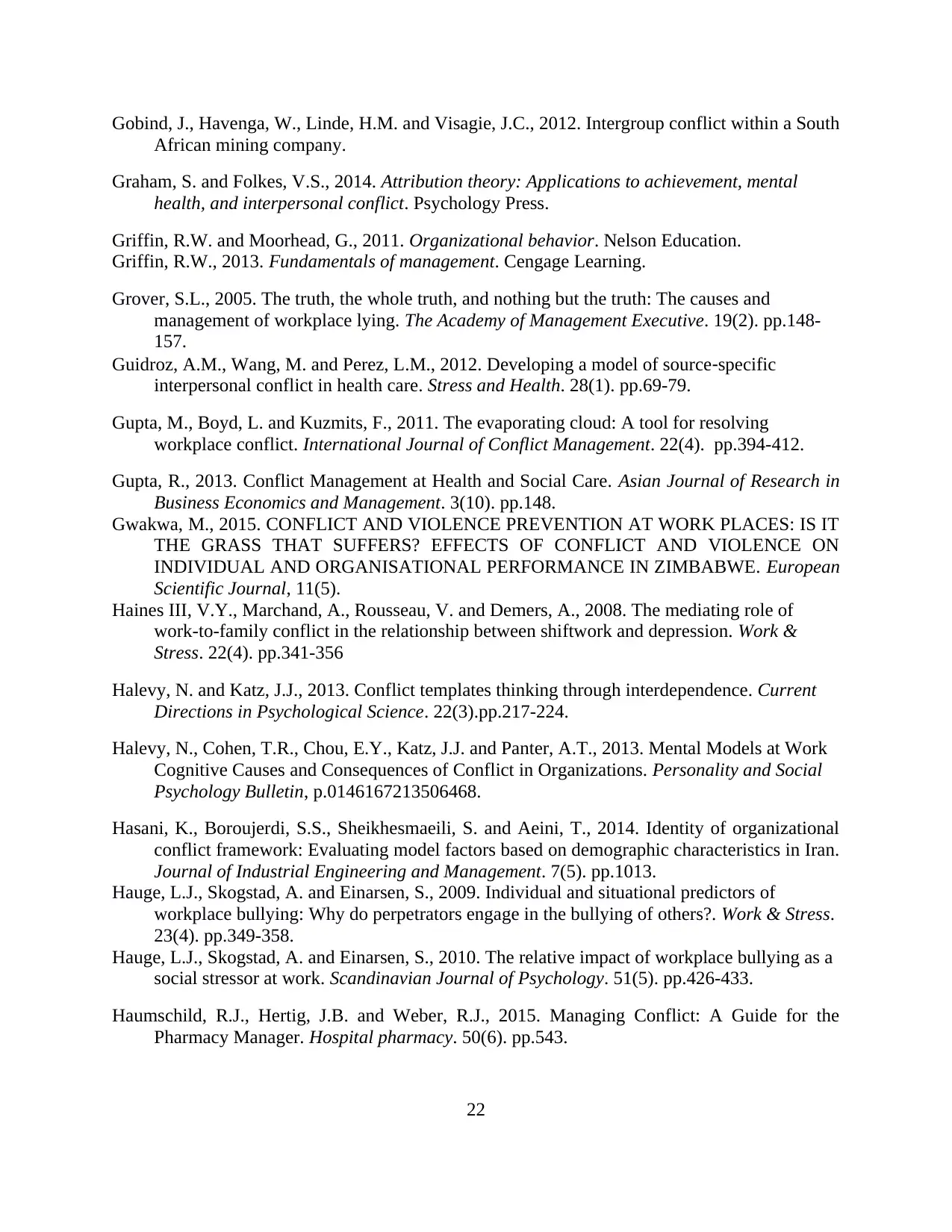
Gobind, J., Havenga, W., Linde, H.M. and Visagie, J.C., 2012. Intergroup conflict within a South
African mining company.
Graham, S. and Folkes, V.S., 2014. Attribution theory: Applications to achievement, mental
health, and interpersonal conflict. Psychology Press.
Griffin, R.W. and Moorhead, G., 2011. Organizational behavior. Nelson Education.
Griffin, R.W., 2013. Fundamentals of management. Cengage Learning.
Grover, S.L., 2005. The truth, the whole truth, and nothing but the truth: The causes and
management of workplace lying. The Academy of Management Executive. 19(2). pp.148-
157.
Guidroz, A.M., Wang, M. and Perez, L.M., 2012. Developing a model of source‐specific
interpersonal conflict in health care. Stress and Health. 28(1). pp.69-79.
Gupta, M., Boyd, L. and Kuzmits, F., 2011. The evaporating cloud: A tool for resolving
workplace conflict. International Journal of Conflict Management. 22(4). pp.394-412.
Gupta, R., 2013. Conflict Management at Health and Social Care. Asian Journal of Research in
Business Economics and Management. 3(10). pp.148.
Gwakwa, M., 2015. CONFLICT AND VIOLENCE PREVENTION AT WORK PLACES: IS IT
THE GRASS THAT SUFFERS? EFFECTS OF CONFLICT AND VIOLENCE ON
INDIVIDUAL AND ORGANISATIONAL PERFORMANCE IN ZIMBABWE. European
Scientific Journal, 11(5).
Haines III, V.Y., Marchand, A., Rousseau, V. and Demers, A., 2008. The mediating role of
work-to-family conflict in the relationship between shiftwork and depression. Work &
Stress. 22(4). pp.341-356
Halevy, N. and Katz, J.J., 2013. Conflict templates thinking through interdependence. Current
Directions in Psychological Science. 22(3).pp.217-224.
Halevy, N., Cohen, T.R., Chou, E.Y., Katz, J.J. and Panter, A.T., 2013. Mental Models at Work
Cognitive Causes and Consequences of Conflict in Organizations. Personality and Social
Psychology Bulletin, p.0146167213506468.
Hasani, K., Boroujerdi, S.S., Sheikhesmaeili, S. and Aeini, T., 2014. Identity of organizational
conflict framework: Evaluating model factors based on demographic characteristics in Iran.
Journal of Industrial Engineering and Management. 7(5). pp.1013.
Hauge, L.J., Skogstad, A. and Einarsen, S., 2009. Individual and situational predictors of
workplace bullying: Why do perpetrators engage in the bullying of others?. Work & Stress.
23(4). pp.349-358.
Hauge, L.J., Skogstad, A. and Einarsen, S., 2010. The relative impact of workplace bullying as a
social stressor at work. Scandinavian Journal of Psychology. 51(5). pp.426-433.
Haumschild, R.J., Hertig, J.B. and Weber, R.J., 2015. Managing Conflict: A Guide for the
Pharmacy Manager. Hospital pharmacy. 50(6). pp.543.
22
African mining company.
Graham, S. and Folkes, V.S., 2014. Attribution theory: Applications to achievement, mental
health, and interpersonal conflict. Psychology Press.
Griffin, R.W. and Moorhead, G., 2011. Organizational behavior. Nelson Education.
Griffin, R.W., 2013. Fundamentals of management. Cengage Learning.
Grover, S.L., 2005. The truth, the whole truth, and nothing but the truth: The causes and
management of workplace lying. The Academy of Management Executive. 19(2). pp.148-
157.
Guidroz, A.M., Wang, M. and Perez, L.M., 2012. Developing a model of source‐specific
interpersonal conflict in health care. Stress and Health. 28(1). pp.69-79.
Gupta, M., Boyd, L. and Kuzmits, F., 2011. The evaporating cloud: A tool for resolving
workplace conflict. International Journal of Conflict Management. 22(4). pp.394-412.
Gupta, R., 2013. Conflict Management at Health and Social Care. Asian Journal of Research in
Business Economics and Management. 3(10). pp.148.
Gwakwa, M., 2015. CONFLICT AND VIOLENCE PREVENTION AT WORK PLACES: IS IT
THE GRASS THAT SUFFERS? EFFECTS OF CONFLICT AND VIOLENCE ON
INDIVIDUAL AND ORGANISATIONAL PERFORMANCE IN ZIMBABWE. European
Scientific Journal, 11(5).
Haines III, V.Y., Marchand, A., Rousseau, V. and Demers, A., 2008. The mediating role of
work-to-family conflict in the relationship between shiftwork and depression. Work &
Stress. 22(4). pp.341-356
Halevy, N. and Katz, J.J., 2013. Conflict templates thinking through interdependence. Current
Directions in Psychological Science. 22(3).pp.217-224.
Halevy, N., Cohen, T.R., Chou, E.Y., Katz, J.J. and Panter, A.T., 2013. Mental Models at Work
Cognitive Causes and Consequences of Conflict in Organizations. Personality and Social
Psychology Bulletin, p.0146167213506468.
Hasani, K., Boroujerdi, S.S., Sheikhesmaeili, S. and Aeini, T., 2014. Identity of organizational
conflict framework: Evaluating model factors based on demographic characteristics in Iran.
Journal of Industrial Engineering and Management. 7(5). pp.1013.
Hauge, L.J., Skogstad, A. and Einarsen, S., 2009. Individual and situational predictors of
workplace bullying: Why do perpetrators engage in the bullying of others?. Work & Stress.
23(4). pp.349-358.
Hauge, L.J., Skogstad, A. and Einarsen, S., 2010. The relative impact of workplace bullying as a
social stressor at work. Scandinavian Journal of Psychology. 51(5). pp.426-433.
Haumschild, R.J., Hertig, J.B. and Weber, R.J., 2015. Managing Conflict: A Guide for the
Pharmacy Manager. Hospital pharmacy. 50(6). pp.543.
22
Secure Best Marks with AI Grader
Need help grading? Try our AI Grader for instant feedback on your assignments.
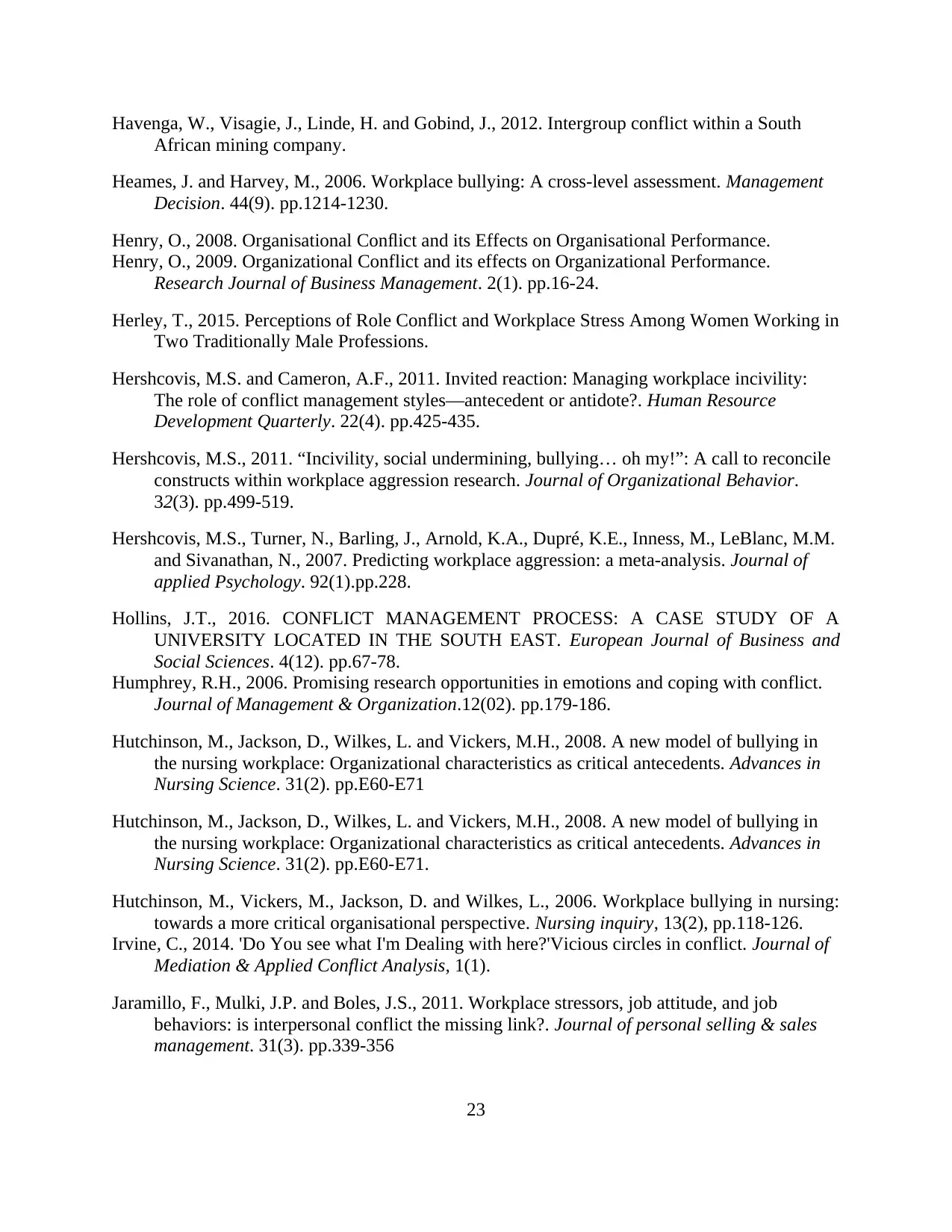
Havenga, W., Visagie, J., Linde, H. and Gobind, J., 2012. Intergroup conflict within a South
African mining company.
Heames, J. and Harvey, M., 2006. Workplace bullying: A cross-level assessment. Management
Decision. 44(9). pp.1214-1230.
Henry, O., 2008. Organisational Conflict and its Effects on Organisational Performance.
Henry, O., 2009. Organizational Conflict and its effects on Organizational Performance.
Research Journal of Business Management. 2(1). pp.16-24.
Herley, T., 2015. Perceptions of Role Conflict and Workplace Stress Among Women Working in
Two Traditionally Male Professions.
Hershcovis, M.S. and Cameron, A.F., 2011. Invited reaction: Managing workplace incivility:
The role of conflict management styles—antecedent or antidote?. Human Resource
Development Quarterly. 22(4). pp.425-435.
Hershcovis, M.S., 2011. “Incivility, social undermining, bullying… oh my!”: A call to reconcile
constructs within workplace aggression research. Journal of Organizational Behavior.
32(3). pp.499-519.
Hershcovis, M.S., Turner, N., Barling, J., Arnold, K.A., Dupré, K.E., Inness, M., LeBlanc, M.M.
and Sivanathan, N., 2007. Predicting workplace aggression: a meta-analysis. Journal of
applied Psychology. 92(1).pp.228.
Hollins, J.T., 2016. CONFLICT MANAGEMENT PROCESS: A CASE STUDY OF A
UNIVERSITY LOCATED IN THE SOUTH EAST. European Journal of Business and
Social Sciences. 4(12). pp.67-78.
Humphrey, R.H., 2006. Promising research opportunities in emotions and coping with conflict.
Journal of Management & Organization.12(02). pp.179-186.
Hutchinson, M., Jackson, D., Wilkes, L. and Vickers, M.H., 2008. A new model of bullying in
the nursing workplace: Organizational characteristics as critical antecedents. Advances in
Nursing Science. 31(2). pp.E60-E71
Hutchinson, M., Jackson, D., Wilkes, L. and Vickers, M.H., 2008. A new model of bullying in
the nursing workplace: Organizational characteristics as critical antecedents. Advances in
Nursing Science. 31(2). pp.E60-E71.
Hutchinson, M., Vickers, M., Jackson, D. and Wilkes, L., 2006. Workplace bullying in nursing:
towards a more critical organisational perspective. Nursing inquiry, 13(2), pp.118-126.
Irvine, C., 2014. 'Do You see what I'm Dealing with here?'Vicious circles in conflict. Journal of
Mediation & Applied Conflict Analysis, 1(1).
Jaramillo, F., Mulki, J.P. and Boles, J.S., 2011. Workplace stressors, job attitude, and job
behaviors: is interpersonal conflict the missing link?. Journal of personal selling & sales
management. 31(3). pp.339-356
23
African mining company.
Heames, J. and Harvey, M., 2006. Workplace bullying: A cross-level assessment. Management
Decision. 44(9). pp.1214-1230.
Henry, O., 2008. Organisational Conflict and its Effects on Organisational Performance.
Henry, O., 2009. Organizational Conflict and its effects on Organizational Performance.
Research Journal of Business Management. 2(1). pp.16-24.
Herley, T., 2015. Perceptions of Role Conflict and Workplace Stress Among Women Working in
Two Traditionally Male Professions.
Hershcovis, M.S. and Cameron, A.F., 2011. Invited reaction: Managing workplace incivility:
The role of conflict management styles—antecedent or antidote?. Human Resource
Development Quarterly. 22(4). pp.425-435.
Hershcovis, M.S., 2011. “Incivility, social undermining, bullying… oh my!”: A call to reconcile
constructs within workplace aggression research. Journal of Organizational Behavior.
32(3). pp.499-519.
Hershcovis, M.S., Turner, N., Barling, J., Arnold, K.A., Dupré, K.E., Inness, M., LeBlanc, M.M.
and Sivanathan, N., 2007. Predicting workplace aggression: a meta-analysis. Journal of
applied Psychology. 92(1).pp.228.
Hollins, J.T., 2016. CONFLICT MANAGEMENT PROCESS: A CASE STUDY OF A
UNIVERSITY LOCATED IN THE SOUTH EAST. European Journal of Business and
Social Sciences. 4(12). pp.67-78.
Humphrey, R.H., 2006. Promising research opportunities in emotions and coping with conflict.
Journal of Management & Organization.12(02). pp.179-186.
Hutchinson, M., Jackson, D., Wilkes, L. and Vickers, M.H., 2008. A new model of bullying in
the nursing workplace: Organizational characteristics as critical antecedents. Advances in
Nursing Science. 31(2). pp.E60-E71
Hutchinson, M., Jackson, D., Wilkes, L. and Vickers, M.H., 2008. A new model of bullying in
the nursing workplace: Organizational characteristics as critical antecedents. Advances in
Nursing Science. 31(2). pp.E60-E71.
Hutchinson, M., Vickers, M., Jackson, D. and Wilkes, L., 2006. Workplace bullying in nursing:
towards a more critical organisational perspective. Nursing inquiry, 13(2), pp.118-126.
Irvine, C., 2014. 'Do You see what I'm Dealing with here?'Vicious circles in conflict. Journal of
Mediation & Applied Conflict Analysis, 1(1).
Jaramillo, F., Mulki, J.P. and Boles, J.S., 2011. Workplace stressors, job attitude, and job
behaviors: is interpersonal conflict the missing link?. Journal of personal selling & sales
management. 31(3). pp.339-356
23
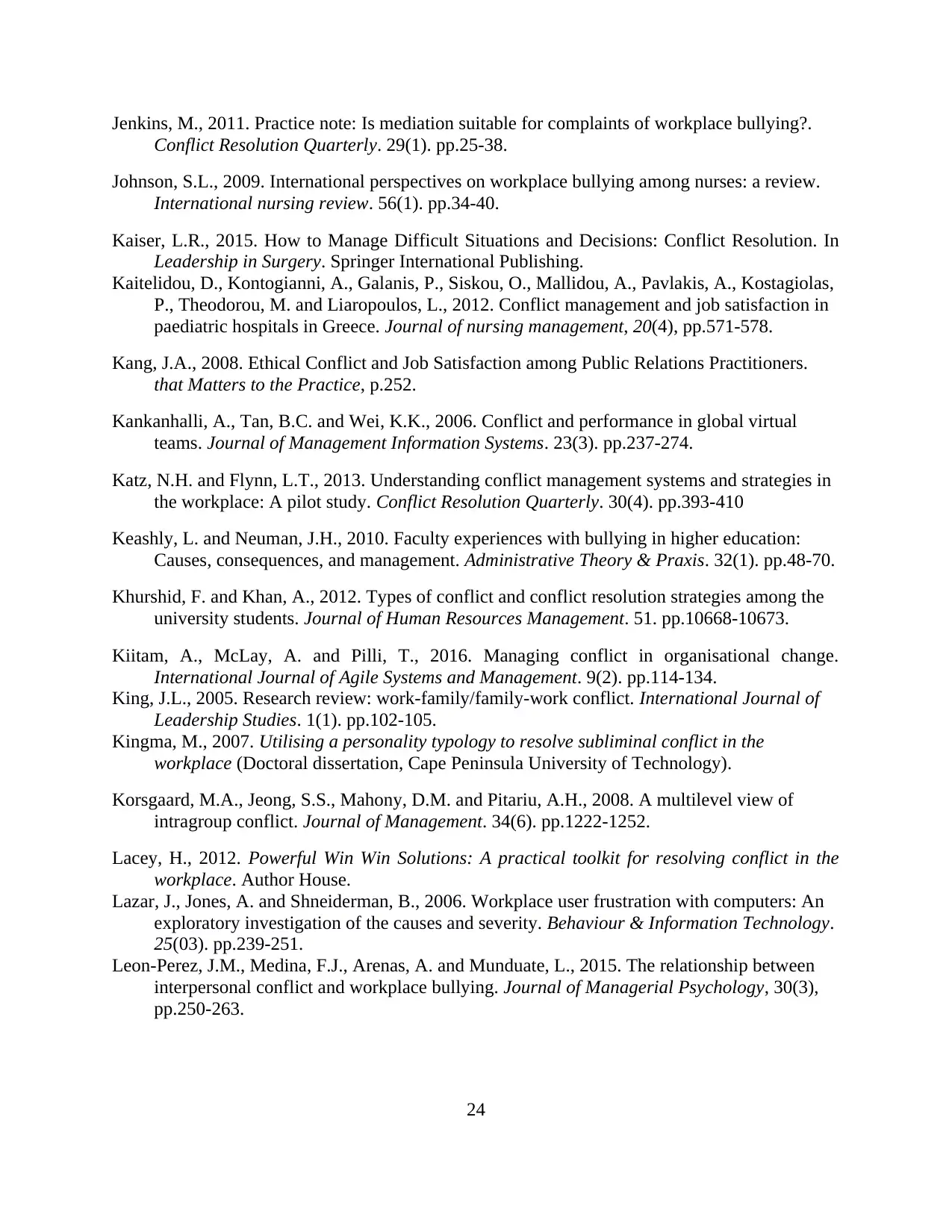
Jenkins, M., 2011. Practice note: Is mediation suitable for complaints of workplace bullying?.
Conflict Resolution Quarterly. 29(1). pp.25-38.
Johnson, S.L., 2009. International perspectives on workplace bullying among nurses: a review.
International nursing review. 56(1). pp.34-40.
Kaiser, L.R., 2015. How to Manage Difficult Situations and Decisions: Conflict Resolution. In
Leadership in Surgery. Springer International Publishing.
Kaitelidou, D., Kontogianni, A., Galanis, P., Siskou, O., Mallidou, A., Pavlakis, A., Kostagiolas,
P., Theodorou, M. and Liaropoulos, L., 2012. Conflict management and job satisfaction in
paediatric hospitals in Greece. Journal of nursing management, 20(4), pp.571-578.
Kang, J.A., 2008. Ethical Conflict and Job Satisfaction among Public Relations Practitioners.
that Matters to the Practice, p.252.
Kankanhalli, A., Tan, B.C. and Wei, K.K., 2006. Conflict and performance in global virtual
teams. Journal of Management Information Systems. 23(3). pp.237-274.
Katz, N.H. and Flynn, L.T., 2013. Understanding conflict management systems and strategies in
the workplace: A pilot study. Conflict Resolution Quarterly. 30(4). pp.393-410
Keashly, L. and Neuman, J.H., 2010. Faculty experiences with bullying in higher education:
Causes, consequences, and management. Administrative Theory & Praxis. 32(1). pp.48-70.
Khurshid, F. and Khan, A., 2012. Types of conflict and conflict resolution strategies among the
university students. Journal of Human Resources Management. 51. pp.10668-10673.
Kiitam, A., McLay, A. and Pilli, T., 2016. Managing conflict in organisational change.
International Journal of Agile Systems and Management. 9(2). pp.114-134.
King, J.L., 2005. Research review: work-family/family-work conflict. International Journal of
Leadership Studies. 1(1). pp.102-105.
Kingma, M., 2007. Utilising a personality typology to resolve subliminal conflict in the
workplace (Doctoral dissertation, Cape Peninsula University of Technology).
Korsgaard, M.A., Jeong, S.S., Mahony, D.M. and Pitariu, A.H., 2008. A multilevel view of
intragroup conflict. Journal of Management. 34(6). pp.1222-1252.
Lacey, H., 2012. Powerful Win Win Solutions: A practical toolkit for resolving conflict in the
workplace. Author House.
Lazar, J., Jones, A. and Shneiderman, B., 2006. Workplace user frustration with computers: An
exploratory investigation of the causes and severity. Behaviour & Information Technology.
25(03). pp.239-251.
Leon-Perez, J.M., Medina, F.J., Arenas, A. and Munduate, L., 2015. The relationship between
interpersonal conflict and workplace bullying. Journal of Managerial Psychology, 30(3),
pp.250-263.
24
Conflict Resolution Quarterly. 29(1). pp.25-38.
Johnson, S.L., 2009. International perspectives on workplace bullying among nurses: a review.
International nursing review. 56(1). pp.34-40.
Kaiser, L.R., 2015. How to Manage Difficult Situations and Decisions: Conflict Resolution. In
Leadership in Surgery. Springer International Publishing.
Kaitelidou, D., Kontogianni, A., Galanis, P., Siskou, O., Mallidou, A., Pavlakis, A., Kostagiolas,
P., Theodorou, M. and Liaropoulos, L., 2012. Conflict management and job satisfaction in
paediatric hospitals in Greece. Journal of nursing management, 20(4), pp.571-578.
Kang, J.A., 2008. Ethical Conflict and Job Satisfaction among Public Relations Practitioners.
that Matters to the Practice, p.252.
Kankanhalli, A., Tan, B.C. and Wei, K.K., 2006. Conflict and performance in global virtual
teams. Journal of Management Information Systems. 23(3). pp.237-274.
Katz, N.H. and Flynn, L.T., 2013. Understanding conflict management systems and strategies in
the workplace: A pilot study. Conflict Resolution Quarterly. 30(4). pp.393-410
Keashly, L. and Neuman, J.H., 2010. Faculty experiences with bullying in higher education:
Causes, consequences, and management. Administrative Theory & Praxis. 32(1). pp.48-70.
Khurshid, F. and Khan, A., 2012. Types of conflict and conflict resolution strategies among the
university students. Journal of Human Resources Management. 51. pp.10668-10673.
Kiitam, A., McLay, A. and Pilli, T., 2016. Managing conflict in organisational change.
International Journal of Agile Systems and Management. 9(2). pp.114-134.
King, J.L., 2005. Research review: work-family/family-work conflict. International Journal of
Leadership Studies. 1(1). pp.102-105.
Kingma, M., 2007. Utilising a personality typology to resolve subliminal conflict in the
workplace (Doctoral dissertation, Cape Peninsula University of Technology).
Korsgaard, M.A., Jeong, S.S., Mahony, D.M. and Pitariu, A.H., 2008. A multilevel view of
intragroup conflict. Journal of Management. 34(6). pp.1222-1252.
Lacey, H., 2012. Powerful Win Win Solutions: A practical toolkit for resolving conflict in the
workplace. Author House.
Lazar, J., Jones, A. and Shneiderman, B., 2006. Workplace user frustration with computers: An
exploratory investigation of the causes and severity. Behaviour & Information Technology.
25(03). pp.239-251.
Leon-Perez, J.M., Medina, F.J., Arenas, A. and Munduate, L., 2015. The relationship between
interpersonal conflict and workplace bullying. Journal of Managerial Psychology, 30(3),
pp.250-263.
24
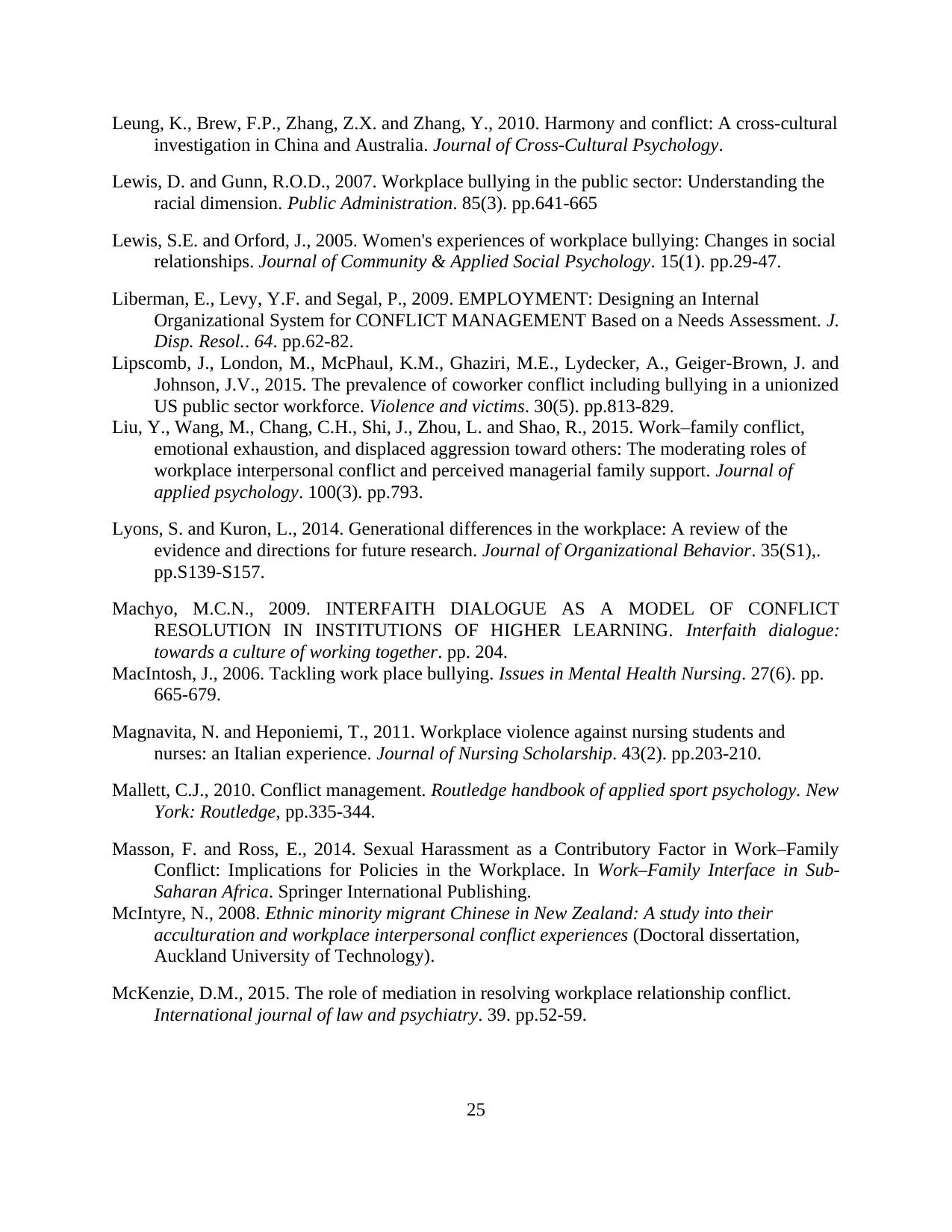
Leung, K., Brew, F.P., Zhang, Z.X. and Zhang, Y., 2010. Harmony and conflict: A cross-cultural
investigation in China and Australia. Journal of Cross-Cultural Psychology.
Lewis, D. and Gunn, R.O.D., 2007. Workplace bullying in the public sector: Understanding the
racial dimension. Public Administration. 85(3). pp.641-665
Lewis, S.E. and Orford, J., 2005. Women's experiences of workplace bullying: Changes in social
relationships. Journal of Community & Applied Social Psychology. 15(1). pp.29-47.
Liberman, E., Levy, Y.F. and Segal, P., 2009. EMPLOYMENT: Designing an Internal
Organizational System for CONFLICT MANAGEMENT Based on a Needs Assessment. J.
Disp. Resol.. 64. pp.62-82.
Lipscomb, J., London, M., McPhaul, K.M., Ghaziri, M.E., Lydecker, A., Geiger-Brown, J. and
Johnson, J.V., 2015. The prevalence of coworker conflict including bullying in a unionized
US public sector workforce. Violence and victims. 30(5). pp.813-829.
Liu, Y., Wang, M., Chang, C.H., Shi, J., Zhou, L. and Shao, R., 2015. Work–family conflict,
emotional exhaustion, and displaced aggression toward others: The moderating roles of
workplace interpersonal conflict and perceived managerial family support. Journal of
applied psychology. 100(3). pp.793.
Lyons, S. and Kuron, L., 2014. Generational differences in the workplace: A review of the
evidence and directions for future research. Journal of Organizational Behavior. 35(S1),.
pp.S139-S157.
Machyo, M.C.N., 2009. INTERFAITH DIALOGUE AS A MODEL OF CONFLICT
RESOLUTION IN INSTITUTIONS OF HIGHER LEARNING. Interfaith dialogue:
towards a culture of working together. pp. 204.
MacIntosh, J., 2006. Tackling work place bullying. Issues in Mental Health Nursing. 27(6). pp.
665-679.
Magnavita, N. and Heponiemi, T., 2011. Workplace violence against nursing students and
nurses: an Italian experience. Journal of Nursing Scholarship. 43(2). pp.203-210.
Mallett, C.J., 2010. Conflict management. Routledge handbook of applied sport psychology. New
York: Routledge, pp.335-344.
Masson, F. and Ross, E., 2014. Sexual Harassment as a Contributory Factor in Work–Family
Conflict: Implications for Policies in the Workplace. In Work–Family Interface in Sub-
Saharan Africa. Springer International Publishing.
McIntyre, N., 2008. Ethnic minority migrant Chinese in New Zealand: A study into their
acculturation and workplace interpersonal conflict experiences (Doctoral dissertation,
Auckland University of Technology).
McKenzie, D.M., 2015. The role of mediation in resolving workplace relationship conflict.
International journal of law and psychiatry. 39. pp.52-59.
25
investigation in China and Australia. Journal of Cross-Cultural Psychology.
Lewis, D. and Gunn, R.O.D., 2007. Workplace bullying in the public sector: Understanding the
racial dimension. Public Administration. 85(3). pp.641-665
Lewis, S.E. and Orford, J., 2005. Women's experiences of workplace bullying: Changes in social
relationships. Journal of Community & Applied Social Psychology. 15(1). pp.29-47.
Liberman, E., Levy, Y.F. and Segal, P., 2009. EMPLOYMENT: Designing an Internal
Organizational System for CONFLICT MANAGEMENT Based on a Needs Assessment. J.
Disp. Resol.. 64. pp.62-82.
Lipscomb, J., London, M., McPhaul, K.M., Ghaziri, M.E., Lydecker, A., Geiger-Brown, J. and
Johnson, J.V., 2015. The prevalence of coworker conflict including bullying in a unionized
US public sector workforce. Violence and victims. 30(5). pp.813-829.
Liu, Y., Wang, M., Chang, C.H., Shi, J., Zhou, L. and Shao, R., 2015. Work–family conflict,
emotional exhaustion, and displaced aggression toward others: The moderating roles of
workplace interpersonal conflict and perceived managerial family support. Journal of
applied psychology. 100(3). pp.793.
Lyons, S. and Kuron, L., 2014. Generational differences in the workplace: A review of the
evidence and directions for future research. Journal of Organizational Behavior. 35(S1),.
pp.S139-S157.
Machyo, M.C.N., 2009. INTERFAITH DIALOGUE AS A MODEL OF CONFLICT
RESOLUTION IN INSTITUTIONS OF HIGHER LEARNING. Interfaith dialogue:
towards a culture of working together. pp. 204.
MacIntosh, J., 2006. Tackling work place bullying. Issues in Mental Health Nursing. 27(6). pp.
665-679.
Magnavita, N. and Heponiemi, T., 2011. Workplace violence against nursing students and
nurses: an Italian experience. Journal of Nursing Scholarship. 43(2). pp.203-210.
Mallett, C.J., 2010. Conflict management. Routledge handbook of applied sport psychology. New
York: Routledge, pp.335-344.
Masson, F. and Ross, E., 2014. Sexual Harassment as a Contributory Factor in Work–Family
Conflict: Implications for Policies in the Workplace. In Work–Family Interface in Sub-
Saharan Africa. Springer International Publishing.
McIntyre, N., 2008. Ethnic minority migrant Chinese in New Zealand: A study into their
acculturation and workplace interpersonal conflict experiences (Doctoral dissertation,
Auckland University of Technology).
McKenzie, D.M., 2015. The role of mediation in resolving workplace relationship conflict.
International journal of law and psychiatry. 39. pp.52-59.
25
Paraphrase This Document
Need a fresh take? Get an instant paraphrase of this document with our AI Paraphraser
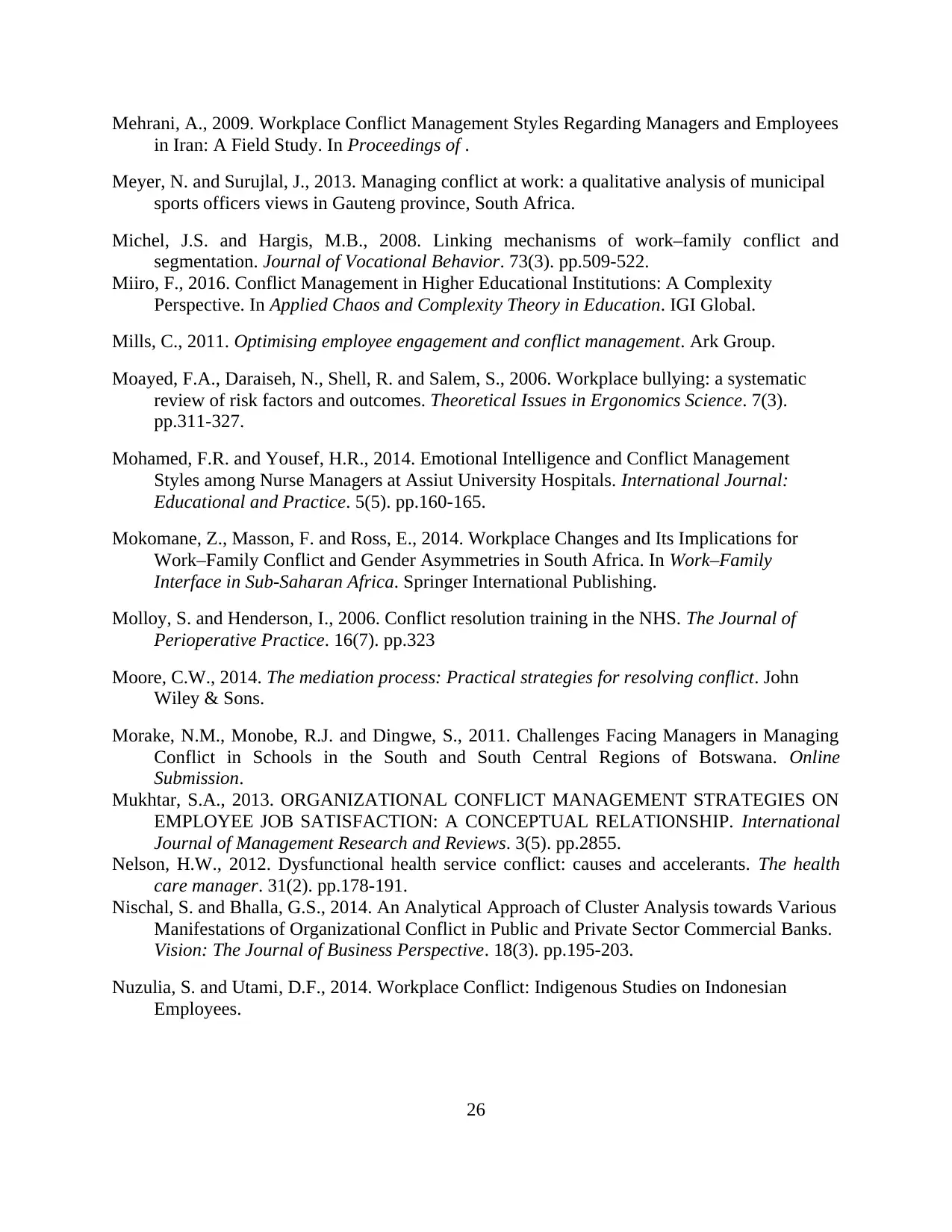
Mehrani, A., 2009. Workplace Conflict Management Styles Regarding Managers and Employees
in Iran: A Field Study. In Proceedings of .
Meyer, N. and Surujlal, J., 2013. Managing conflict at work: a qualitative analysis of municipal
sports officers views in Gauteng province, South Africa.
Michel, J.S. and Hargis, M.B., 2008. Linking mechanisms of work–family conflict and
segmentation. Journal of Vocational Behavior. 73(3). pp.509-522.
Miiro, F., 2016. Conflict Management in Higher Educational Institutions: A Complexity
Perspective. In Applied Chaos and Complexity Theory in Education. IGI Global.
Mills, C., 2011. Optimising employee engagement and conflict management. Ark Group.
Moayed, F.A., Daraiseh, N., Shell, R. and Salem, S., 2006. Workplace bullying: a systematic
review of risk factors and outcomes. Theoretical Issues in Ergonomics Science. 7(3).
pp.311-327.
Mohamed, F.R. and Yousef, H.R., 2014. Emotional Intelligence and Conflict Management
Styles among Nurse Managers at Assiut University Hospitals. International Journal:
Educational and Practice. 5(5). pp.160-165.
Mokomane, Z., Masson, F. and Ross, E., 2014. Workplace Changes and Its Implications for
Work–Family Conflict and Gender Asymmetries in South Africa. In Work–Family
Interface in Sub-Saharan Africa. Springer International Publishing.
Molloy, S. and Henderson, I., 2006. Conflict resolution training in the NHS. The Journal of
Perioperative Practice. 16(7). pp.323
Moore, C.W., 2014. The mediation process: Practical strategies for resolving conflict. John
Wiley & Sons.
Morake, N.M., Monobe, R.J. and Dingwe, S., 2011. Challenges Facing Managers in Managing
Conflict in Schools in the South and South Central Regions of Botswana. Online
Submission.
Mukhtar, S.A., 2013. ORGANIZATIONAL CONFLICT MANAGEMENT STRATEGIES ON
EMPLOYEE JOB SATISFACTION: A CONCEPTUAL RELATIONSHIP. International
Journal of Management Research and Reviews. 3(5). pp.2855.
Nelson, H.W., 2012. Dysfunctional health service conflict: causes and accelerants. The health
care manager. 31(2). pp.178-191.
Nischal, S. and Bhalla, G.S., 2014. An Analytical Approach of Cluster Analysis towards Various
Manifestations of Organizational Conflict in Public and Private Sector Commercial Banks.
Vision: The Journal of Business Perspective. 18(3). pp.195-203.
Nuzulia, S. and Utami, D.F., 2014. Workplace Conflict: Indigenous Studies on Indonesian
Employees.
26
in Iran: A Field Study. In Proceedings of .
Meyer, N. and Surujlal, J., 2013. Managing conflict at work: a qualitative analysis of municipal
sports officers views in Gauteng province, South Africa.
Michel, J.S. and Hargis, M.B., 2008. Linking mechanisms of work–family conflict and
segmentation. Journal of Vocational Behavior. 73(3). pp.509-522.
Miiro, F., 2016. Conflict Management in Higher Educational Institutions: A Complexity
Perspective. In Applied Chaos and Complexity Theory in Education. IGI Global.
Mills, C., 2011. Optimising employee engagement and conflict management. Ark Group.
Moayed, F.A., Daraiseh, N., Shell, R. and Salem, S., 2006. Workplace bullying: a systematic
review of risk factors and outcomes. Theoretical Issues in Ergonomics Science. 7(3).
pp.311-327.
Mohamed, F.R. and Yousef, H.R., 2014. Emotional Intelligence and Conflict Management
Styles among Nurse Managers at Assiut University Hospitals. International Journal:
Educational and Practice. 5(5). pp.160-165.
Mokomane, Z., Masson, F. and Ross, E., 2014. Workplace Changes and Its Implications for
Work–Family Conflict and Gender Asymmetries in South Africa. In Work–Family
Interface in Sub-Saharan Africa. Springer International Publishing.
Molloy, S. and Henderson, I., 2006. Conflict resolution training in the NHS. The Journal of
Perioperative Practice. 16(7). pp.323
Moore, C.W., 2014. The mediation process: Practical strategies for resolving conflict. John
Wiley & Sons.
Morake, N.M., Monobe, R.J. and Dingwe, S., 2011. Challenges Facing Managers in Managing
Conflict in Schools in the South and South Central Regions of Botswana. Online
Submission.
Mukhtar, S.A., 2013. ORGANIZATIONAL CONFLICT MANAGEMENT STRATEGIES ON
EMPLOYEE JOB SATISFACTION: A CONCEPTUAL RELATIONSHIP. International
Journal of Management Research and Reviews. 3(5). pp.2855.
Nelson, H.W., 2012. Dysfunctional health service conflict: causes and accelerants. The health
care manager. 31(2). pp.178-191.
Nischal, S. and Bhalla, G.S., 2014. An Analytical Approach of Cluster Analysis towards Various
Manifestations of Organizational Conflict in Public and Private Sector Commercial Banks.
Vision: The Journal of Business Perspective. 18(3). pp.195-203.
Nuzulia, S. and Utami, D.F., 2014. Workplace Conflict: Indigenous Studies on Indonesian
Employees.
26
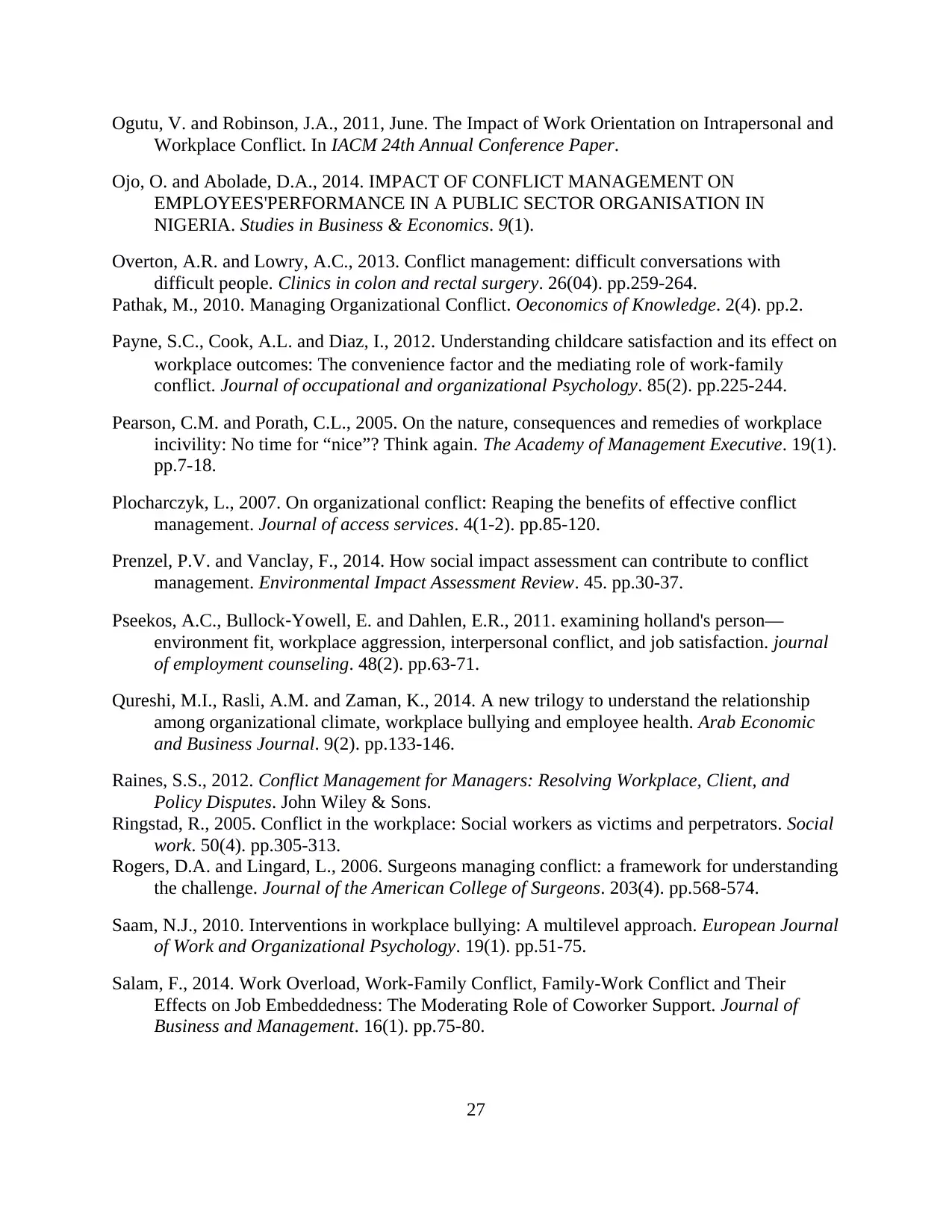
Ogutu, V. and Robinson, J.A., 2011, June. The Impact of Work Orientation on Intrapersonal and
Workplace Conflict. In IACM 24th Annual Conference Paper.
Ojo, O. and Abolade, D.A., 2014. IMPACT OF CONFLICT MANAGEMENT ON
EMPLOYEES'PERFORMANCE IN A PUBLIC SECTOR ORGANISATION IN
NIGERIA. Studies in Business & Economics. 9(1).
Overton, A.R. and Lowry, A.C., 2013. Conflict management: difficult conversations with
difficult people. Clinics in colon and rectal surgery. 26(04). pp.259-264.
Pathak, M., 2010. Managing Organizational Conflict. Oeconomics of Knowledge. 2(4). pp.2.
Payne, S.C., Cook, A.L. and Diaz, I., 2012. Understanding childcare satisfaction and its effect on
workplace outcomes: The convenience factor and the mediating role of work‐family
conflict. Journal of occupational and organizational Psychology. 85(2). pp.225-244.
Pearson, C.M. and Porath, C.L., 2005. On the nature, consequences and remedies of workplace
incivility: No time for “nice”? Think again. The Academy of Management Executive. 19(1).
pp.7-18.
Plocharczyk, L., 2007. On organizational conflict: Reaping the benefits of effective conflict
management. Journal of access services. 4(1-2). pp.85-120.
Prenzel, P.V. and Vanclay, F., 2014. How social impact assessment can contribute to conflict
management. Environmental Impact Assessment Review. 45. pp.30-37.
Pseekos, A.C., Bullock‐Yowell, E. and Dahlen, E.R., 2011. examining holland's person—
environment fit, workplace aggression, interpersonal conflict, and job satisfaction. journal
of employment counseling. 48(2). pp.63-71.
Qureshi, M.I., Rasli, A.M. and Zaman, K., 2014. A new trilogy to understand the relationship
among organizational climate, workplace bullying and employee health. Arab Economic
and Business Journal. 9(2). pp.133-146.
Raines, S.S., 2012. Conflict Management for Managers: Resolving Workplace, Client, and
Policy Disputes. John Wiley & Sons.
Ringstad, R., 2005. Conflict in the workplace: Social workers as victims and perpetrators. Social
work. 50(4). pp.305-313.
Rogers, D.A. and Lingard, L., 2006. Surgeons managing conflict: a framework for understanding
the challenge. Journal of the American College of Surgeons. 203(4). pp.568-574.
Saam, N.J., 2010. Interventions in workplace bullying: A multilevel approach. European Journal
of Work and Organizational Psychology. 19(1). pp.51-75.
Salam, F., 2014. Work Overload, Work-Family Conflict, Family-Work Conflict and Their
Effects on Job Embeddedness: The Moderating Role of Coworker Support. Journal of
Business and Management. 16(1). pp.75-80.
27
Workplace Conflict. In IACM 24th Annual Conference Paper.
Ojo, O. and Abolade, D.A., 2014. IMPACT OF CONFLICT MANAGEMENT ON
EMPLOYEES'PERFORMANCE IN A PUBLIC SECTOR ORGANISATION IN
NIGERIA. Studies in Business & Economics. 9(1).
Overton, A.R. and Lowry, A.C., 2013. Conflict management: difficult conversations with
difficult people. Clinics in colon and rectal surgery. 26(04). pp.259-264.
Pathak, M., 2010. Managing Organizational Conflict. Oeconomics of Knowledge. 2(4). pp.2.
Payne, S.C., Cook, A.L. and Diaz, I., 2012. Understanding childcare satisfaction and its effect on
workplace outcomes: The convenience factor and the mediating role of work‐family
conflict. Journal of occupational and organizational Psychology. 85(2). pp.225-244.
Pearson, C.M. and Porath, C.L., 2005. On the nature, consequences and remedies of workplace
incivility: No time for “nice”? Think again. The Academy of Management Executive. 19(1).
pp.7-18.
Plocharczyk, L., 2007. On organizational conflict: Reaping the benefits of effective conflict
management. Journal of access services. 4(1-2). pp.85-120.
Prenzel, P.V. and Vanclay, F., 2014. How social impact assessment can contribute to conflict
management. Environmental Impact Assessment Review. 45. pp.30-37.
Pseekos, A.C., Bullock‐Yowell, E. and Dahlen, E.R., 2011. examining holland's person—
environment fit, workplace aggression, interpersonal conflict, and job satisfaction. journal
of employment counseling. 48(2). pp.63-71.
Qureshi, M.I., Rasli, A.M. and Zaman, K., 2014. A new trilogy to understand the relationship
among organizational climate, workplace bullying and employee health. Arab Economic
and Business Journal. 9(2). pp.133-146.
Raines, S.S., 2012. Conflict Management for Managers: Resolving Workplace, Client, and
Policy Disputes. John Wiley & Sons.
Ringstad, R., 2005. Conflict in the workplace: Social workers as victims and perpetrators. Social
work. 50(4). pp.305-313.
Rogers, D.A. and Lingard, L., 2006. Surgeons managing conflict: a framework for understanding
the challenge. Journal of the American College of Surgeons. 203(4). pp.568-574.
Saam, N.J., 2010. Interventions in workplace bullying: A multilevel approach. European Journal
of Work and Organizational Psychology. 19(1). pp.51-75.
Salam, F., 2014. Work Overload, Work-Family Conflict, Family-Work Conflict and Their
Effects on Job Embeddedness: The Moderating Role of Coworker Support. Journal of
Business and Management. 16(1). pp.75-80.
27

Salin, D. and Hoel, H., 2011. Organisational causes of workplace bullying. Bullying and
harassment in the workplace: Developments in theory, research, and practice, pp.227-243.
Salleh, M.J. and Adulpakdee, A., 2012. Causes of conflict and effective methods to conflict
management at Islamic secondary schools in Yala, Thailand. International
Interdisciplinary Journal of Education. 1(1). pp.15-22.
Saltman, D.C., O’Dea, N.A. and Kidd, M.R., 2006. Conflict management: a primer for doctors in
training. Postgraduate medical journal. 82(963). pp.9-12.
Sandhu, S.J., Farooqi, Y.A. and Sajid, M.R., 2013. Linking Leadership Styles with Workplace
Cognitive/task Conflict. Middle-East Journal of Scientific Research. 17(6), pp.805-813.
Saundry, R., Adam, D., Ashman, I., Forde, C., Wibberley, G. and Wright, S., 2016. Managing
individual conflict in the contemporary British workplace.
Sav, A., Harris, N. and Sebar, B., 2013. Work-life conflict and facilitation among Australian
Muslim men. Equality, Diversity and Inclusion: An International Journal. 32(7). pp.671-
687.
Schieman, S. and Reid, S., 2008. Job authority and interpersonal conflict in the workplace. Work
and Occupations. 35(3). pp.296-326.
Scott, S., 2012. The Impact of Culture on Workplace Conflict in the Caribbean. Cultural
Variations and Business Performance: Contemporary Globalism: Contemporary
Globalism, p.292.
SENTUNA, M., 2013. An investigation of causes of conflict men and women officers working at
the General Directorate of Sports. Turkish Journal of Sport and Exercise. 15(2). pp.107-
111.
Shallcross, L., Ramsay, S. and Barker, M., 2013. Severe Workplace Conflict: The Experience of
Mobbing. Negotiation and Conflict Management Research. 6(3). pp.191-213.
Sharma, P., 2014. Ways of conflict resolution adopted by supporting and non-teaching staff in
management schools. Pranjana. 17(2). pp.46.
Shin, Y., 2005. Conflict resolution in virtual teams. Organizational Dynamics. 34(4). pp.331-
345.
Simpao, A.F., 2013. Conflict management in the health care workplace. Physician Exec, pp.54-6.
Sliter, M.T., Pui, S.Y., Sliter, K.A. and Jex, S.M., 2011. The differential effects of interpersonal
conflict from customers and coworkers: Trait anger as a moderator. Journal of
Occupational Health Psychology. 16(4). pp.424.
Sorensen, G., Landsbergis, P., Hammer, L., Amick III, B.C., Linnan, L., Yancey, A., Welch,
L.S., Goetzel, R.Z., Flannery, K.M. and Pratt, C., 2011. Preventing chronic disease in the
workplace: a workshop report and recommendations. American journal of public health.
101(S1). pp.S196-S207.
Speedy, S., 2006. Workplace violence: the dark side of organisational life. Contemporary Nurse.
21(2). pp.239-250.
28
harassment in the workplace: Developments in theory, research, and practice, pp.227-243.
Salleh, M.J. and Adulpakdee, A., 2012. Causes of conflict and effective methods to conflict
management at Islamic secondary schools in Yala, Thailand. International
Interdisciplinary Journal of Education. 1(1). pp.15-22.
Saltman, D.C., O’Dea, N.A. and Kidd, M.R., 2006. Conflict management: a primer for doctors in
training. Postgraduate medical journal. 82(963). pp.9-12.
Sandhu, S.J., Farooqi, Y.A. and Sajid, M.R., 2013. Linking Leadership Styles with Workplace
Cognitive/task Conflict. Middle-East Journal of Scientific Research. 17(6), pp.805-813.
Saundry, R., Adam, D., Ashman, I., Forde, C., Wibberley, G. and Wright, S., 2016. Managing
individual conflict in the contemporary British workplace.
Sav, A., Harris, N. and Sebar, B., 2013. Work-life conflict and facilitation among Australian
Muslim men. Equality, Diversity and Inclusion: An International Journal. 32(7). pp.671-
687.
Schieman, S. and Reid, S., 2008. Job authority and interpersonal conflict in the workplace. Work
and Occupations. 35(3). pp.296-326.
Scott, S., 2012. The Impact of Culture on Workplace Conflict in the Caribbean. Cultural
Variations and Business Performance: Contemporary Globalism: Contemporary
Globalism, p.292.
SENTUNA, M., 2013. An investigation of causes of conflict men and women officers working at
the General Directorate of Sports. Turkish Journal of Sport and Exercise. 15(2). pp.107-
111.
Shallcross, L., Ramsay, S. and Barker, M., 2013. Severe Workplace Conflict: The Experience of
Mobbing. Negotiation and Conflict Management Research. 6(3). pp.191-213.
Sharma, P., 2014. Ways of conflict resolution adopted by supporting and non-teaching staff in
management schools. Pranjana. 17(2). pp.46.
Shin, Y., 2005. Conflict resolution in virtual teams. Organizational Dynamics. 34(4). pp.331-
345.
Simpao, A.F., 2013. Conflict management in the health care workplace. Physician Exec, pp.54-6.
Sliter, M.T., Pui, S.Y., Sliter, K.A. and Jex, S.M., 2011. The differential effects of interpersonal
conflict from customers and coworkers: Trait anger as a moderator. Journal of
Occupational Health Psychology. 16(4). pp.424.
Sorensen, G., Landsbergis, P., Hammer, L., Amick III, B.C., Linnan, L., Yancey, A., Welch,
L.S., Goetzel, R.Z., Flannery, K.M. and Pratt, C., 2011. Preventing chronic disease in the
workplace: a workshop report and recommendations. American journal of public health.
101(S1). pp.S196-S207.
Speedy, S., 2006. Workplace violence: the dark side of organisational life. Contemporary Nurse.
21(2). pp.239-250.
28
1 out of 28
Related Documents
Your All-in-One AI-Powered Toolkit for Academic Success.
+13062052269
info@desklib.com
Available 24*7 on WhatsApp / Email
![[object Object]](/_next/static/media/star-bottom.7253800d.svg)
Unlock your academic potential
© 2024 | Zucol Services PVT LTD | All rights reserved.





